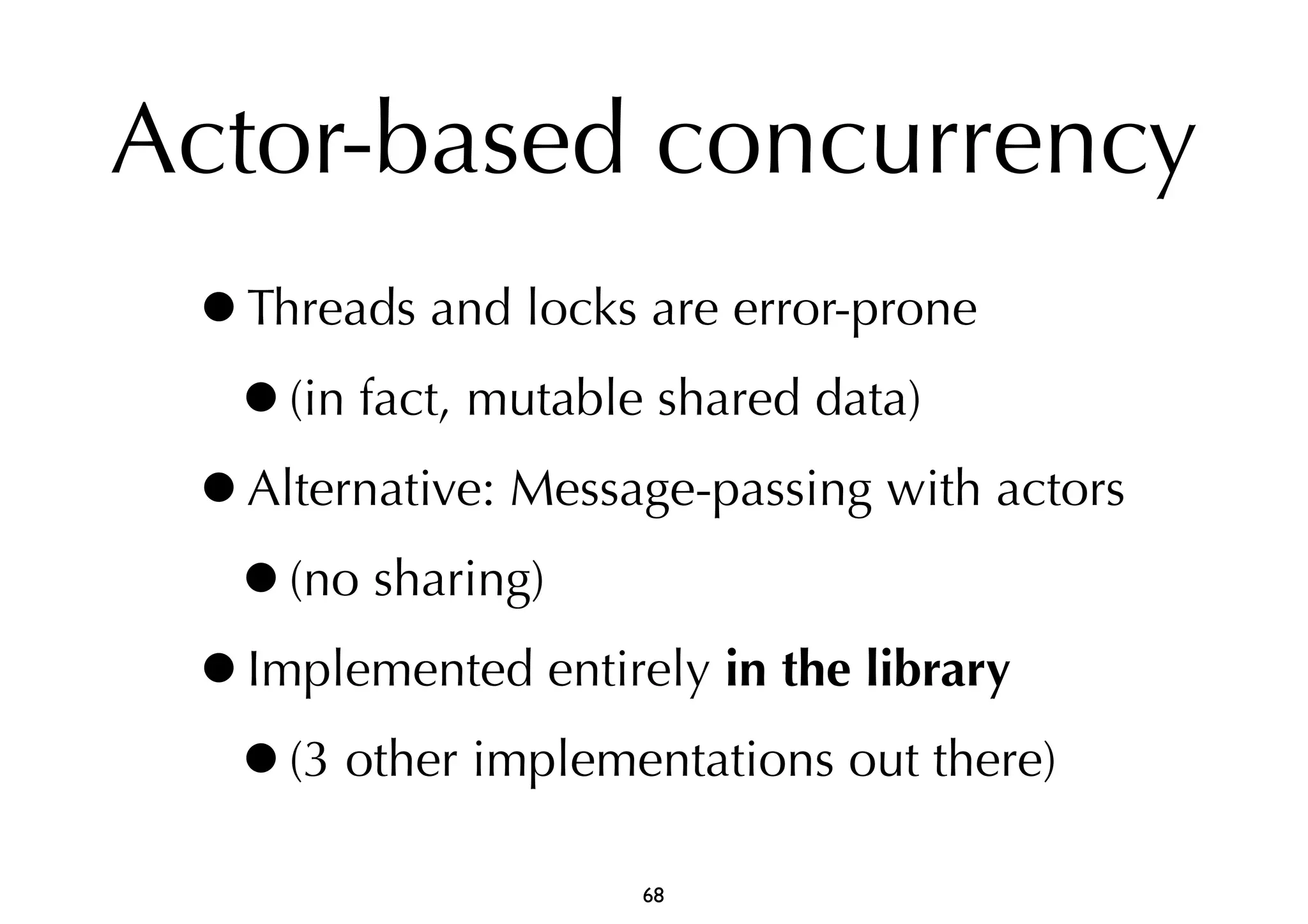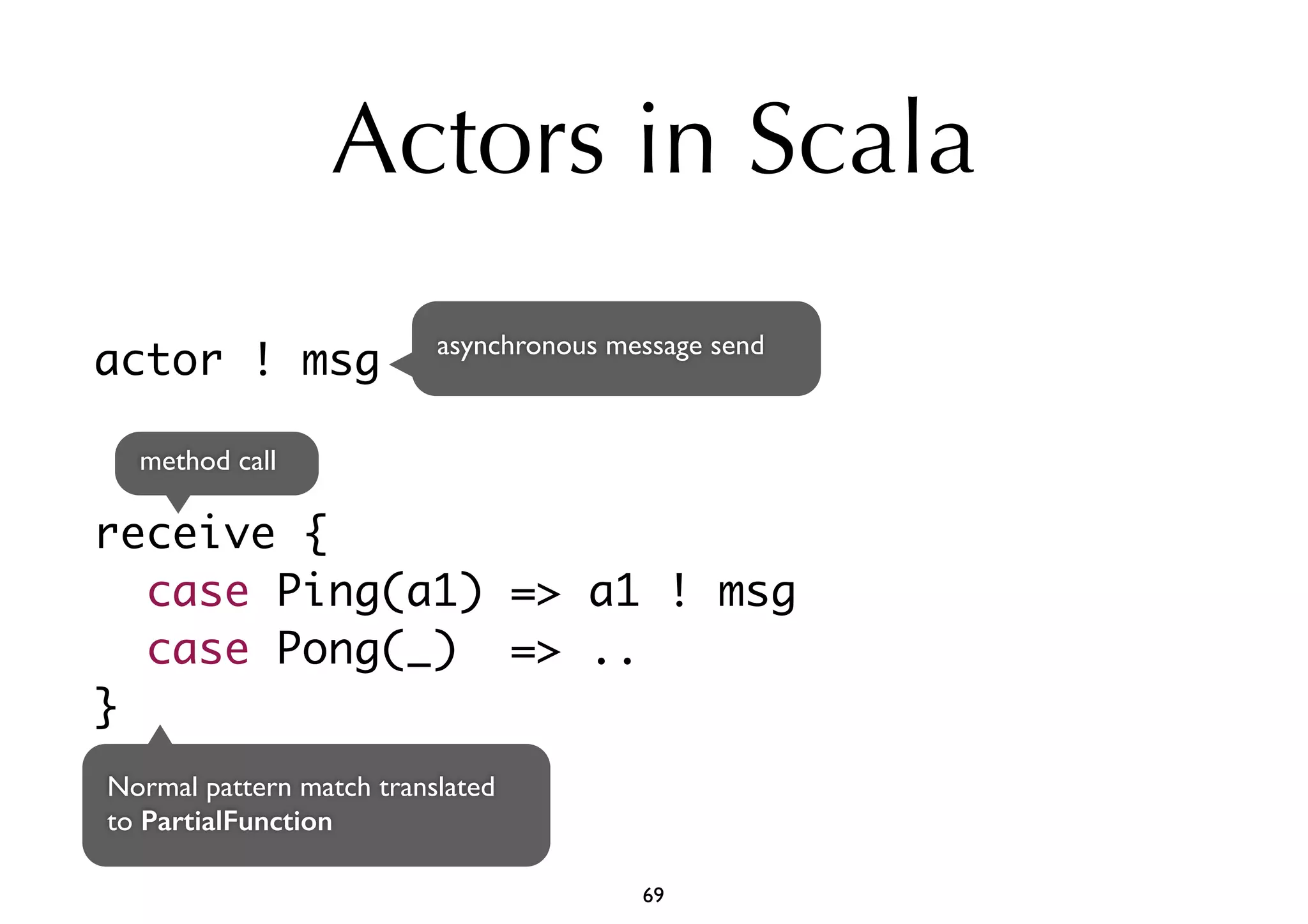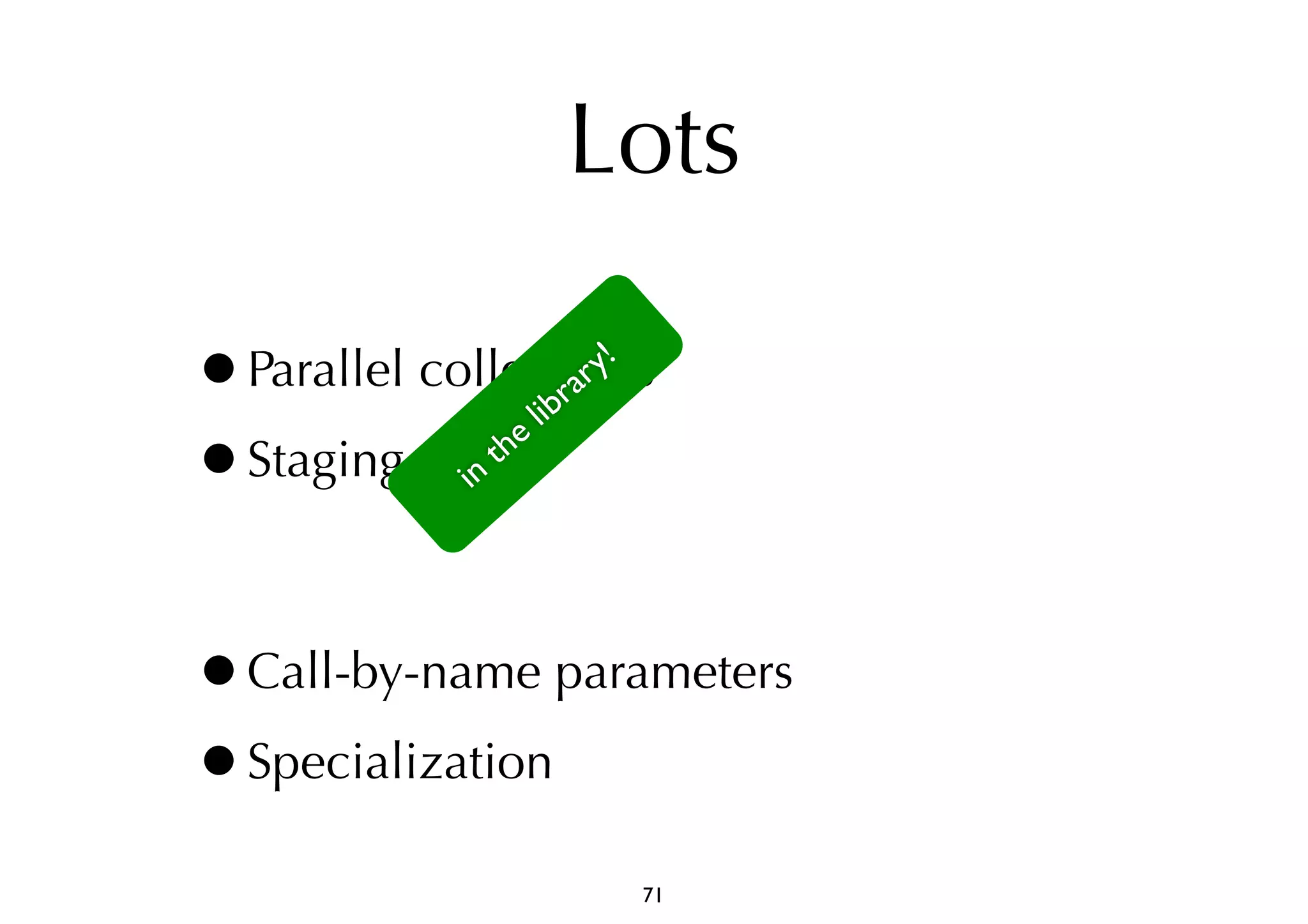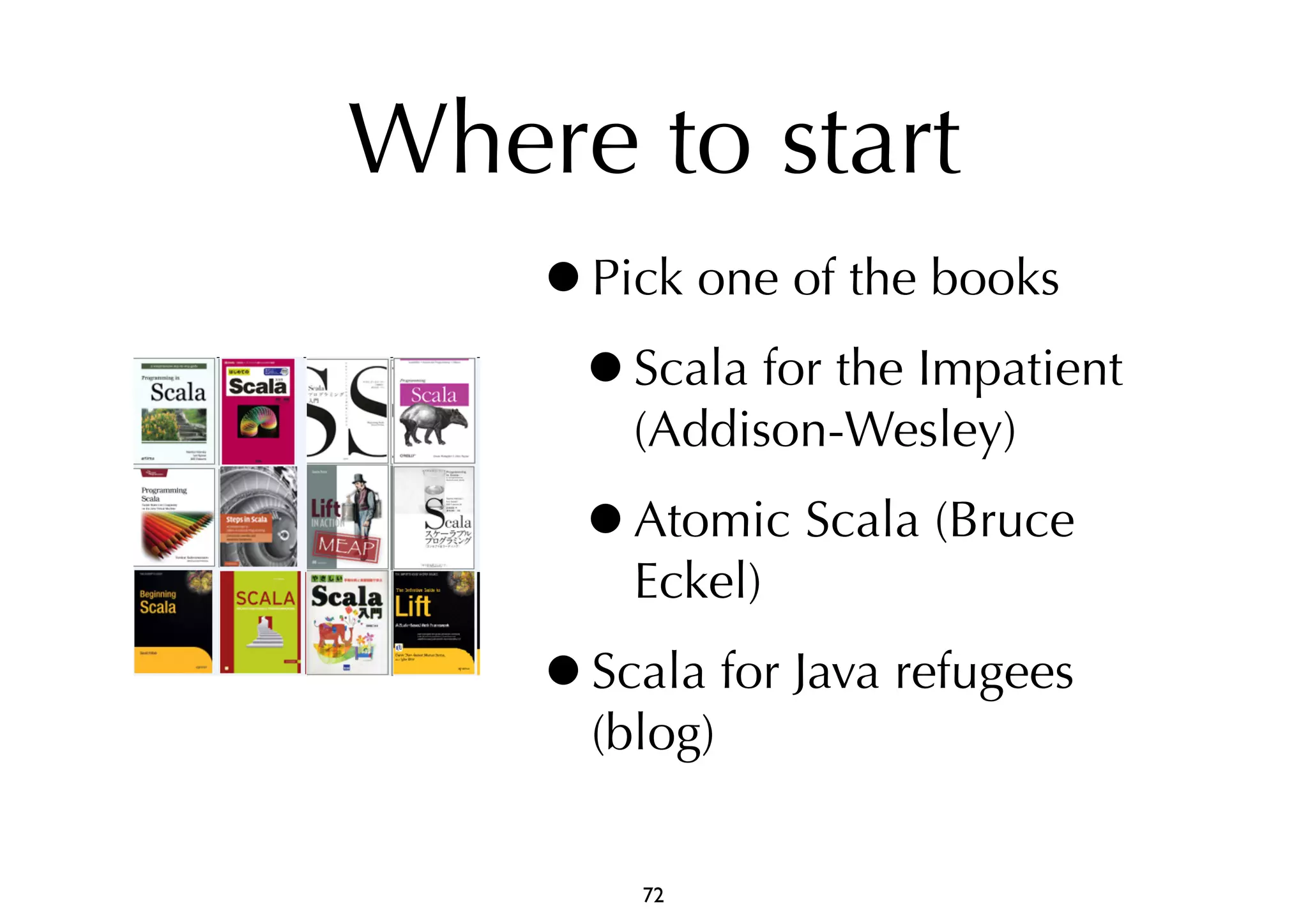Scala is a programming language that combines object-oriented and functional programming paradigms, running on the JVM and offering interoperability with Java. It features concise syntax, type inference, and advanced concepts like mix-in composition and pattern matching, making it suitable for scalable applications. The language emphasizes functions as first-class values, immutability, and a powerful standard library with both mutable and immutable collections.
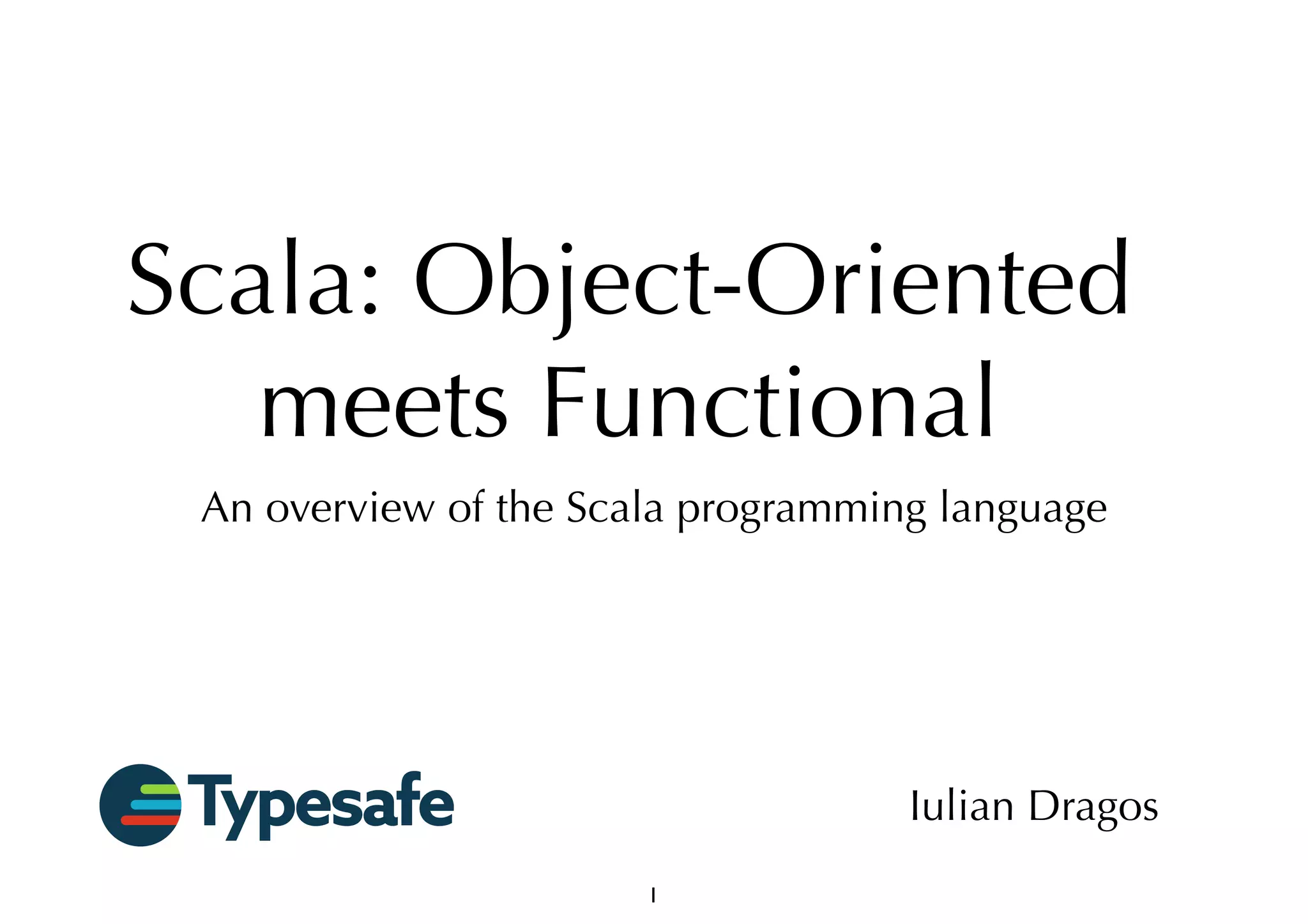
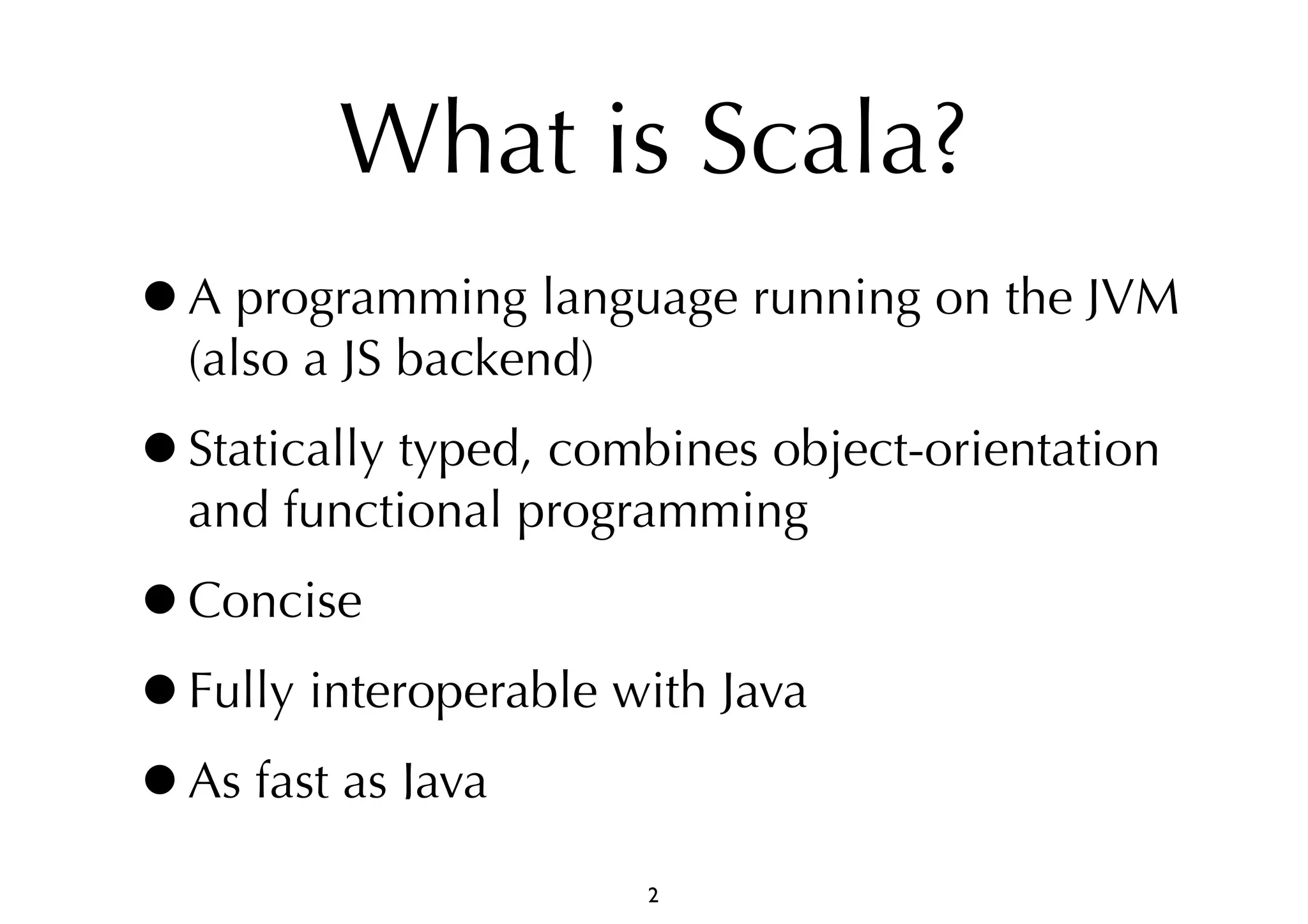
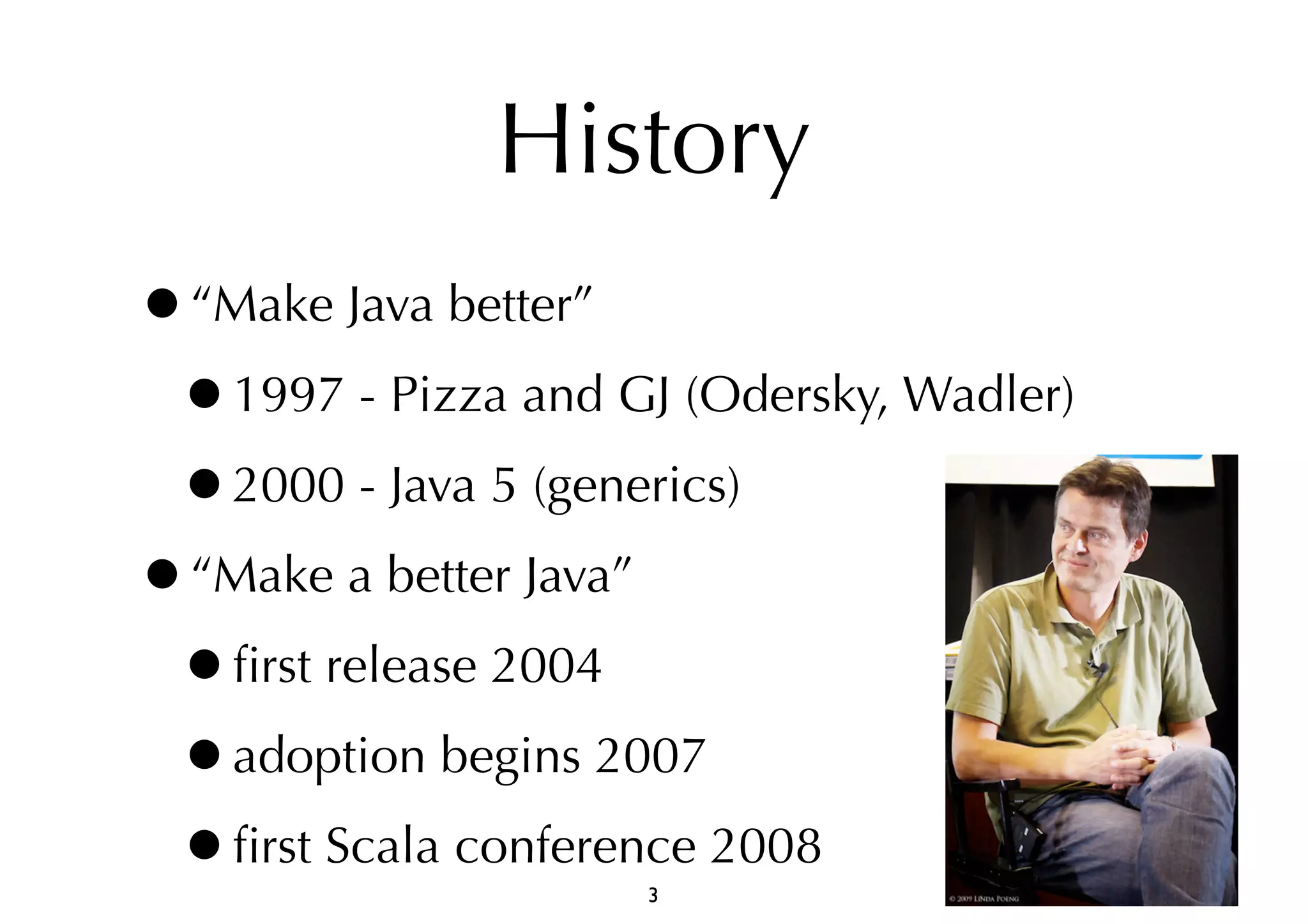

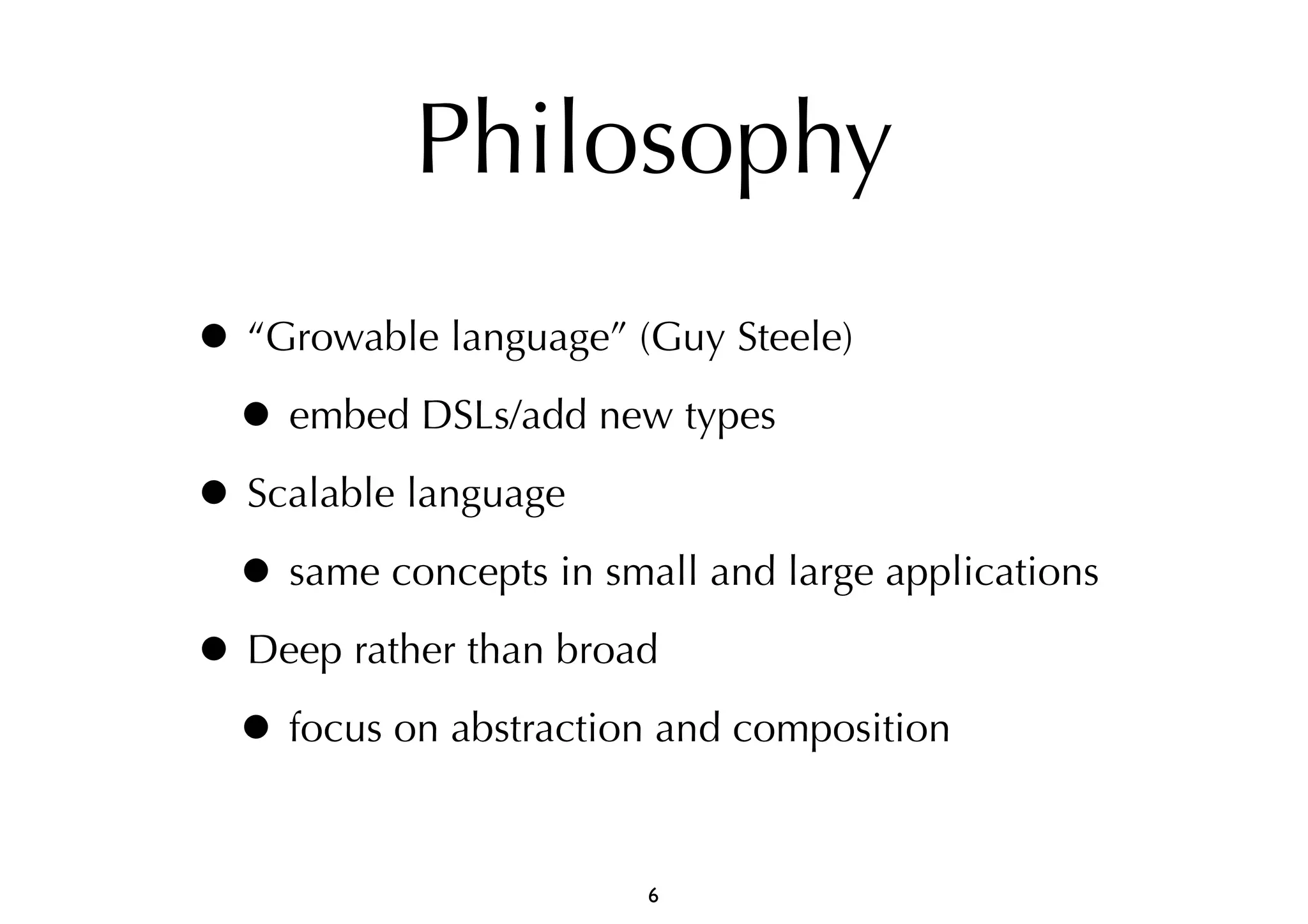
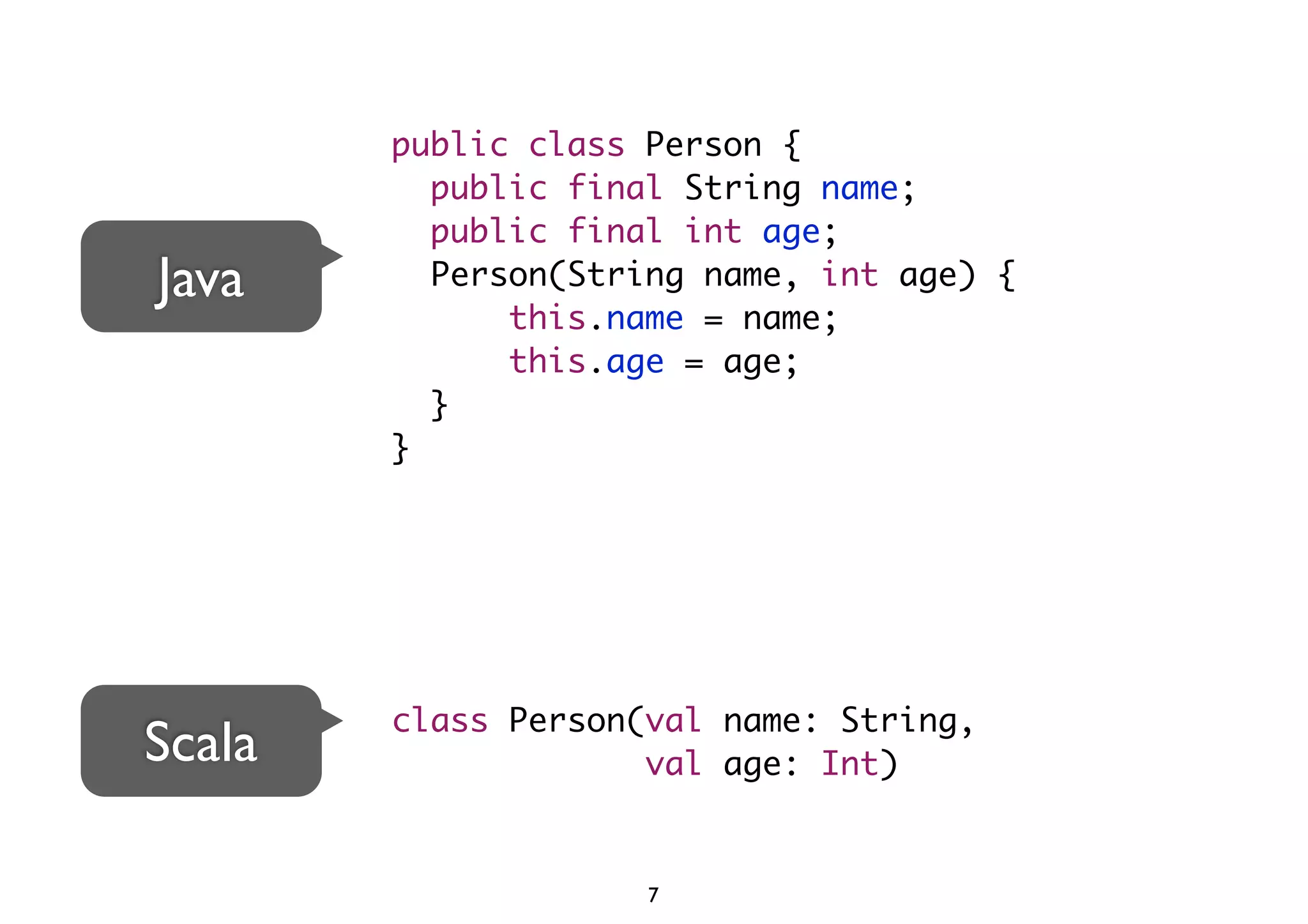
![import java.util.ArrayList;
...
Person[] people;
Person[] minors;
Person[] adults;
{ ArrayList<Person> minorsList = new ArrayList<Person>();
ArrayList<Person> adultsList = new ArrayList<Person>();
for (int i = 0; i < people.length; i++)
(people[i].age < 18 ? minorsList : adultsList)
.add(people[i]);
minors = minorsList.toArray(people);
adults = adultsList.toArray(people);
}
val people: Array[Person]
val (minors, adults) = people partition (_.age < 18)
A tuple in a pattern match
Infix method call
Anonymous function
8](https://image.slidesharecdn.com/scalaintroidragos-141117184923-conversion-gate01/75/Scala-Object-Oriented-Meets-Functional-by-Iulian-Dragos-7-2048.jpg)
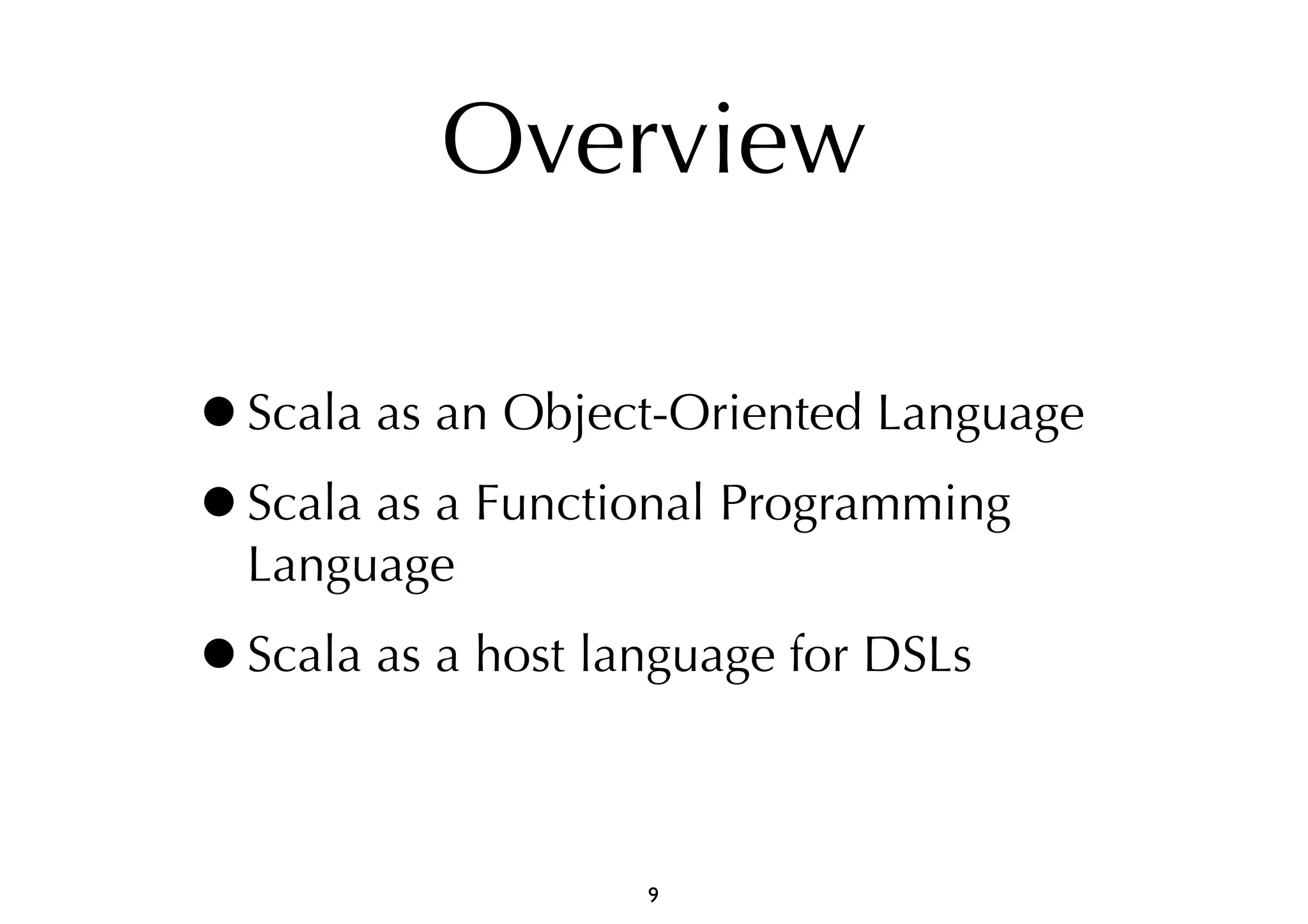
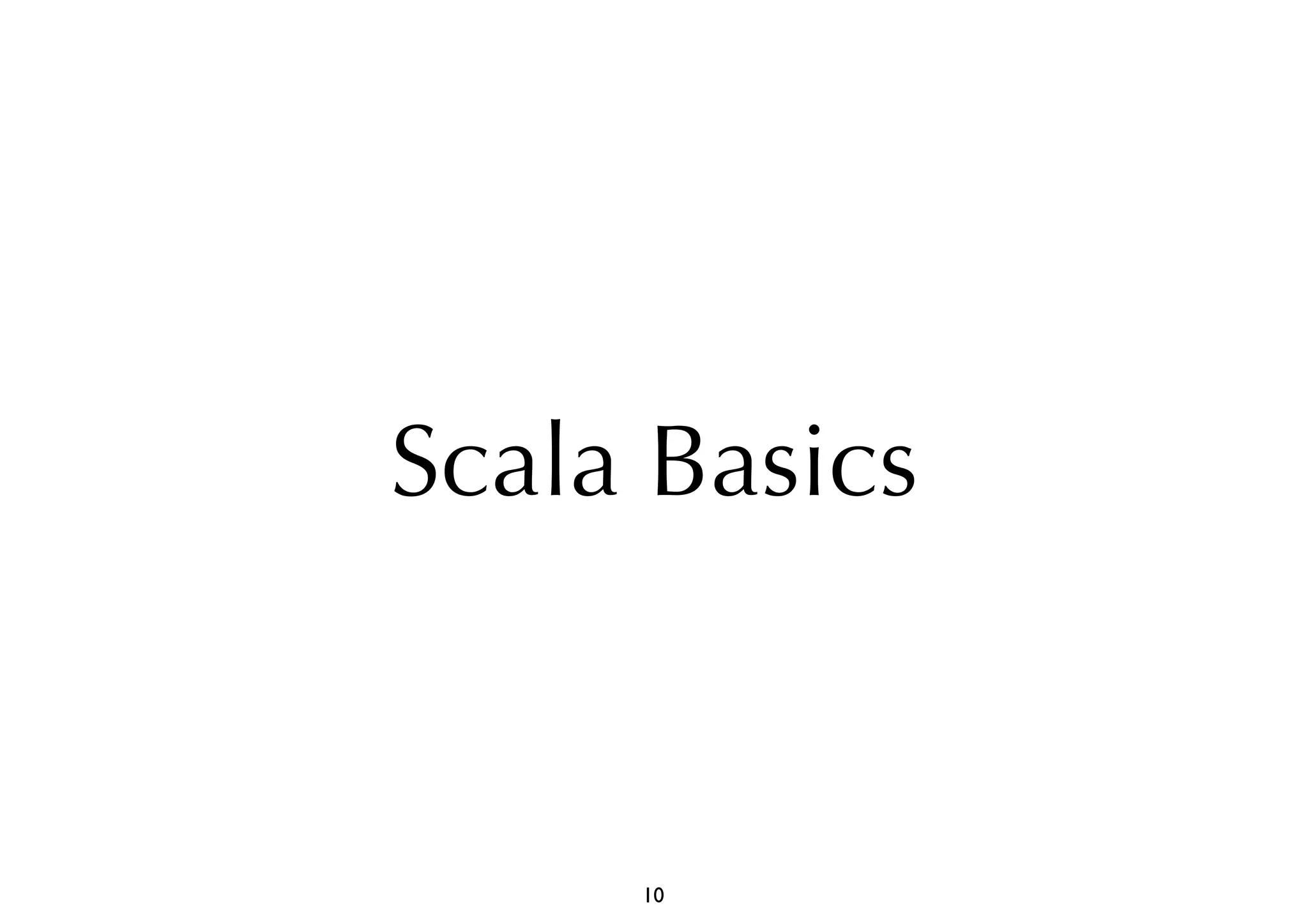
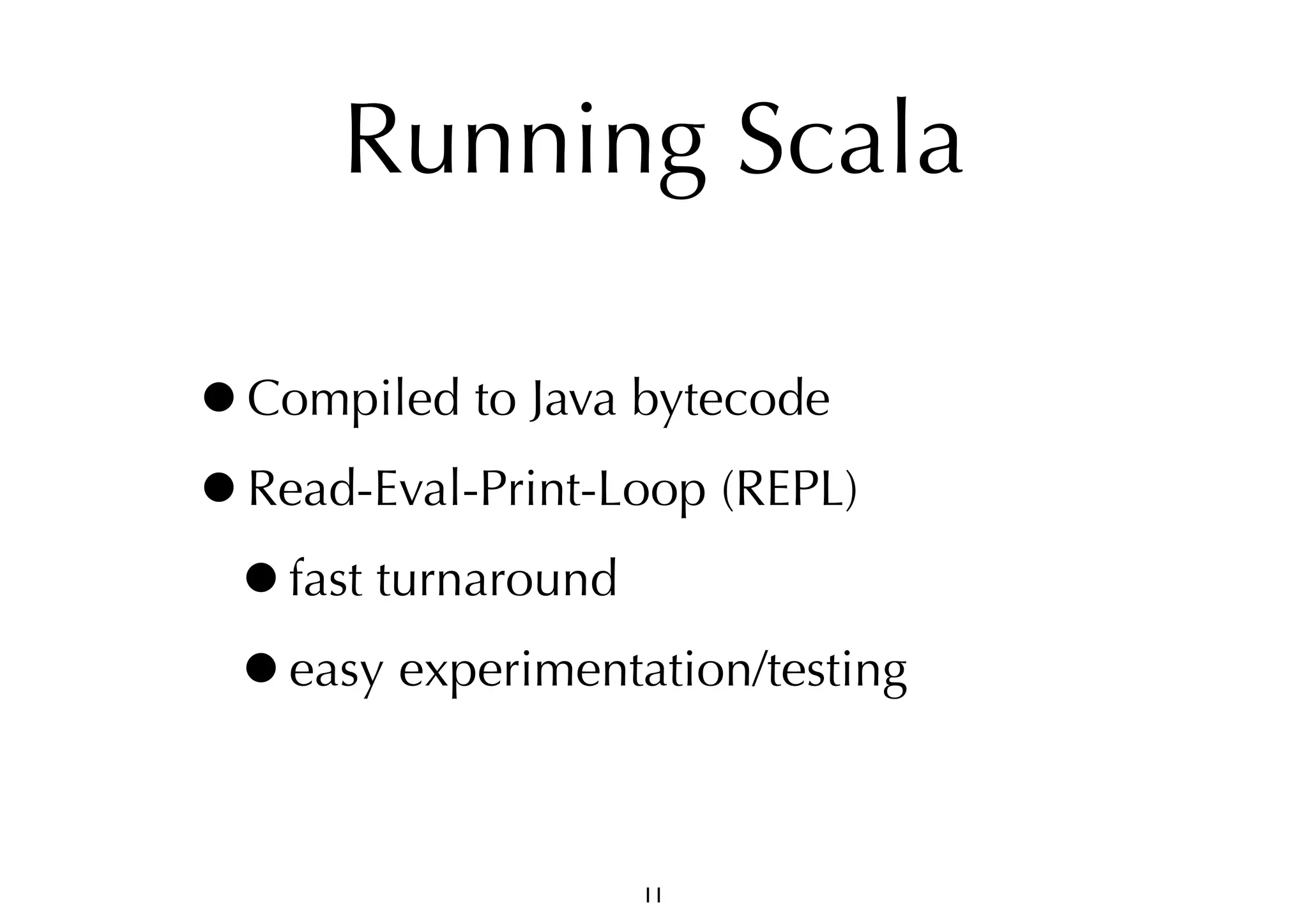
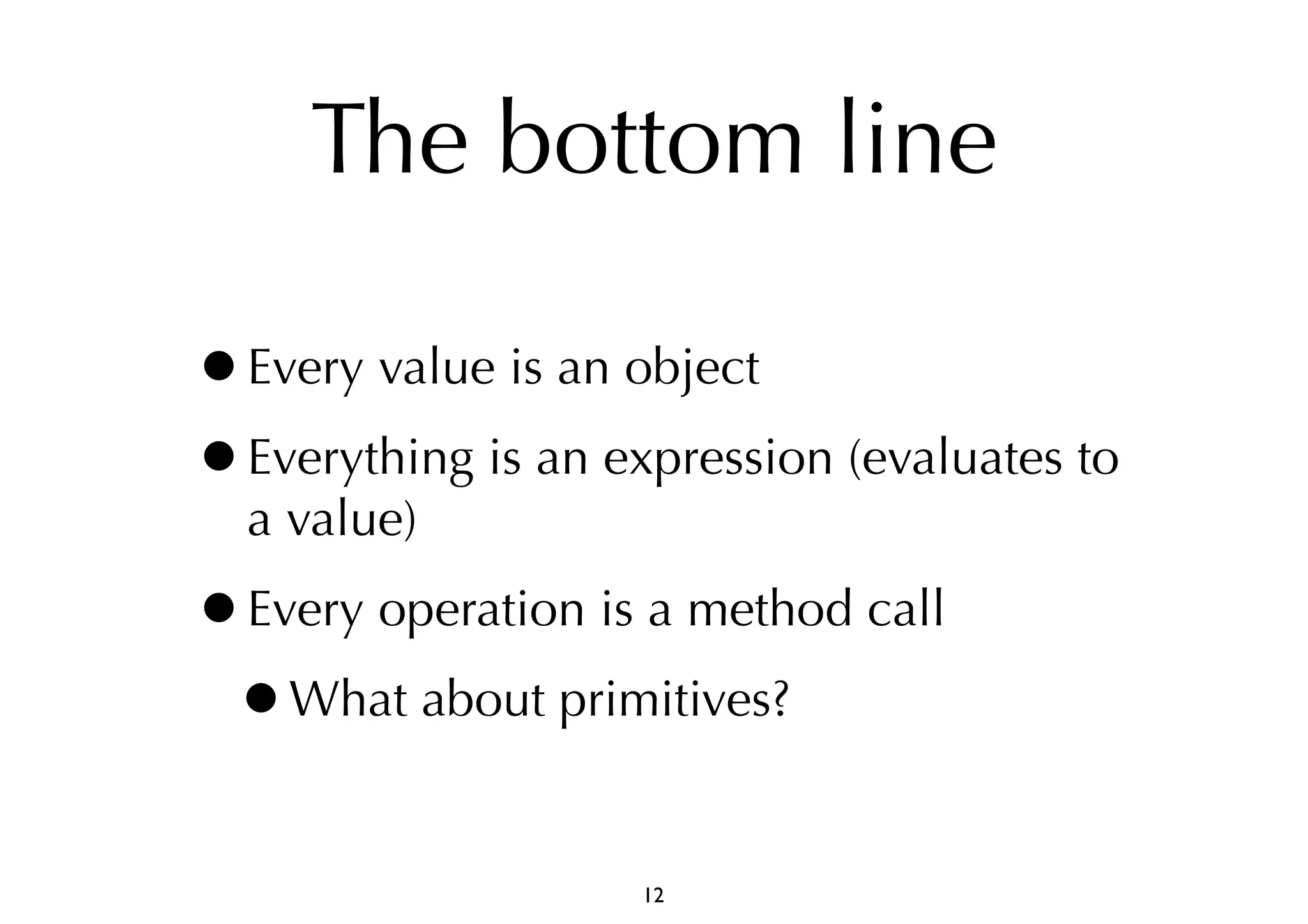
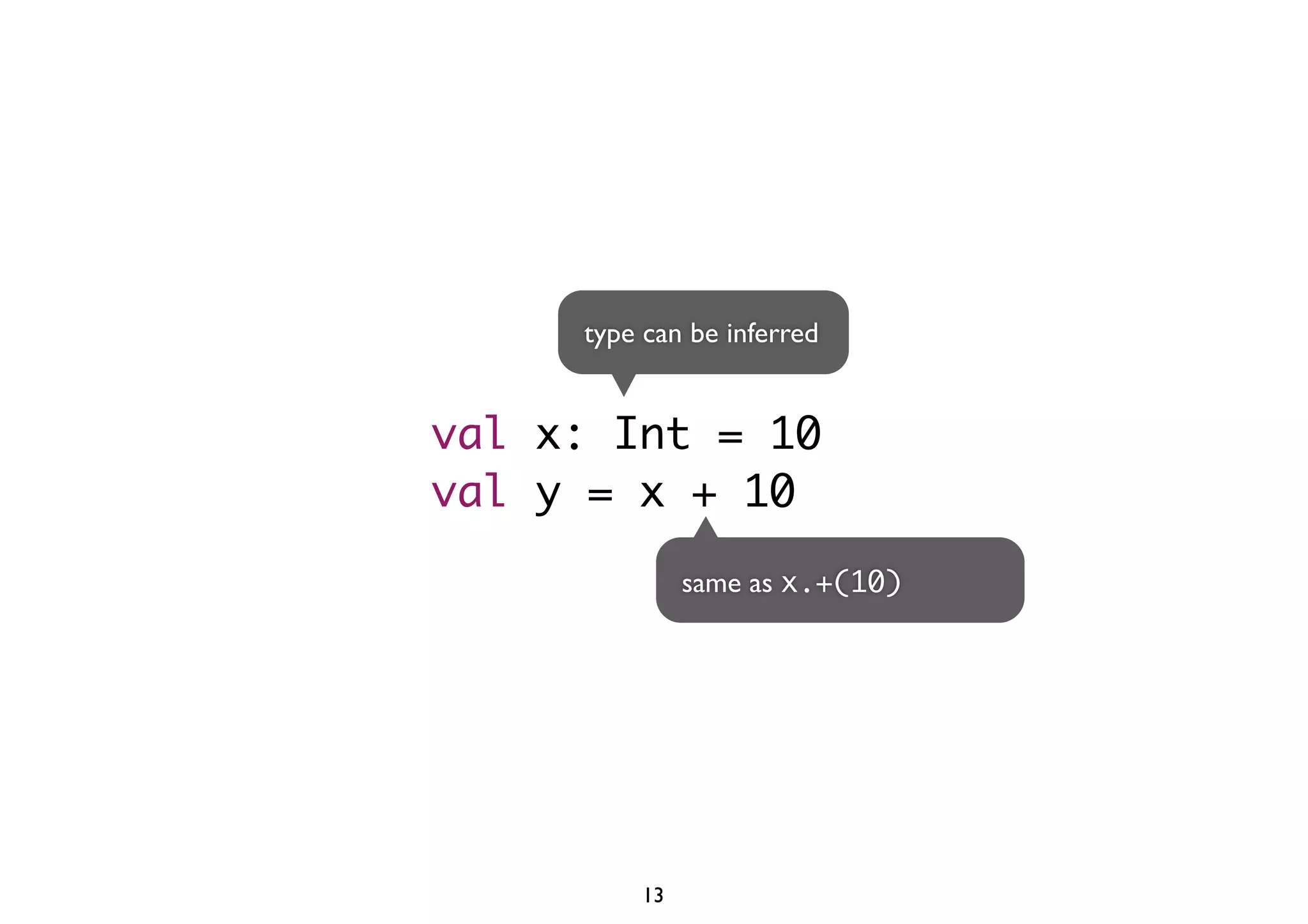
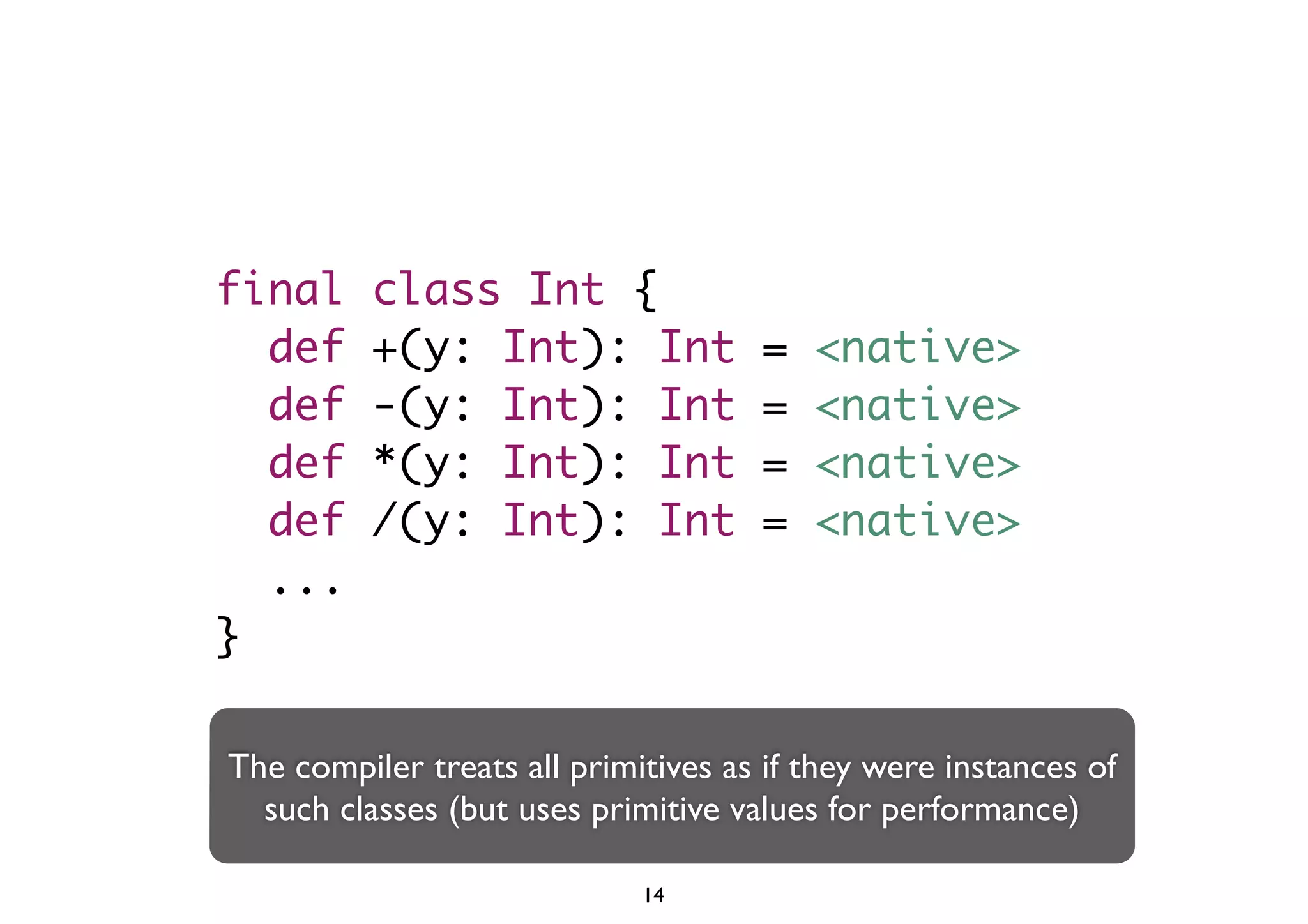
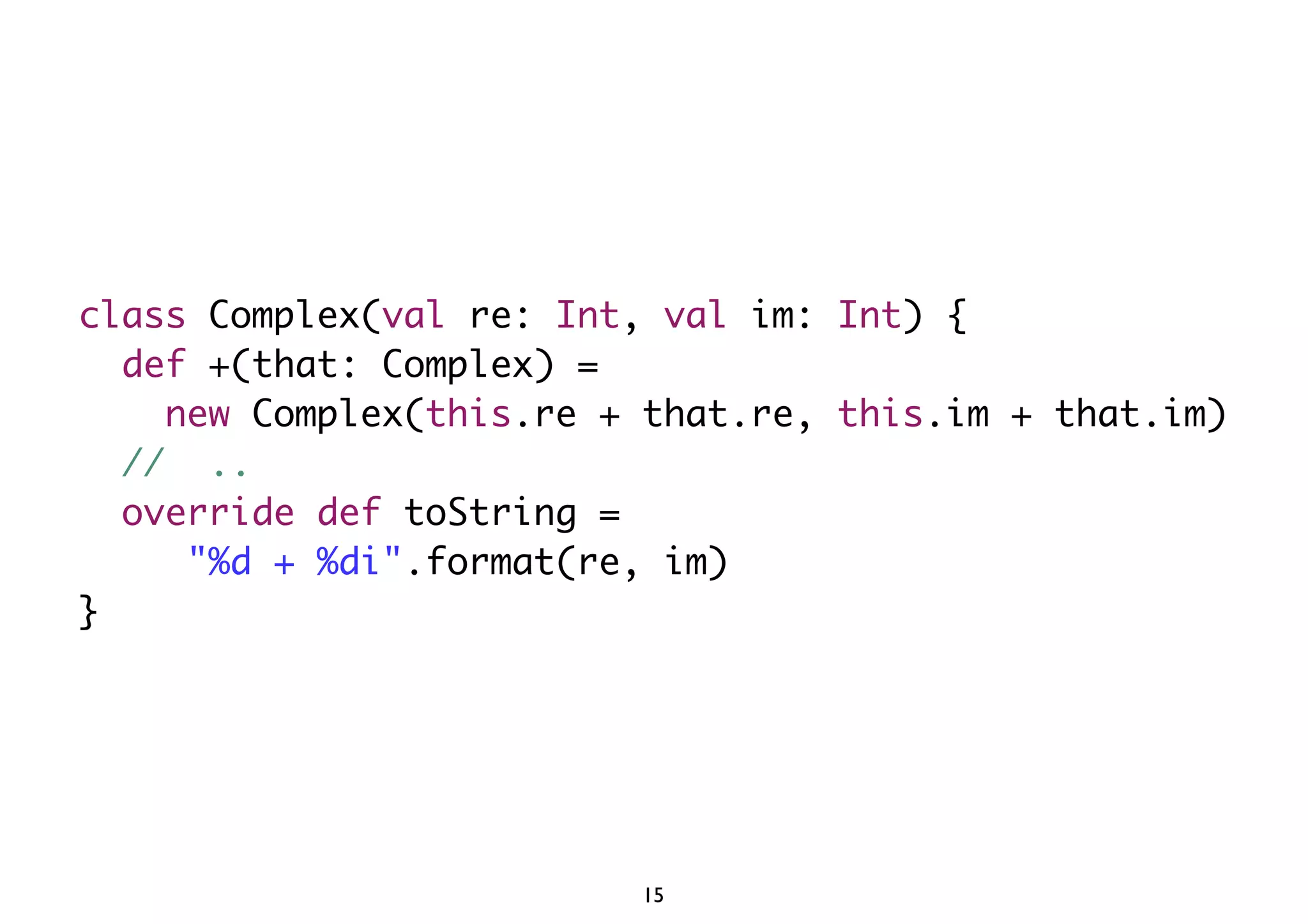
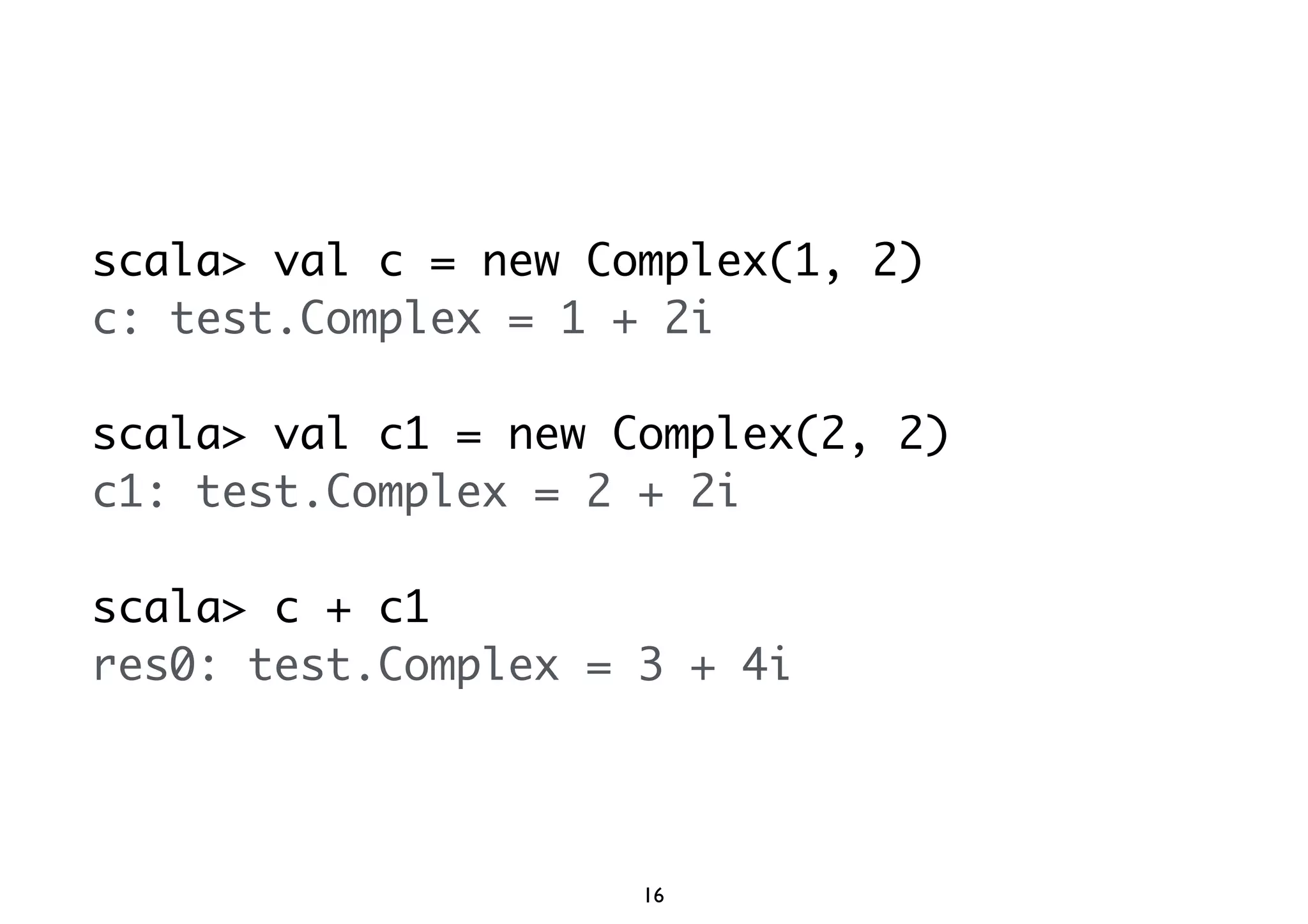
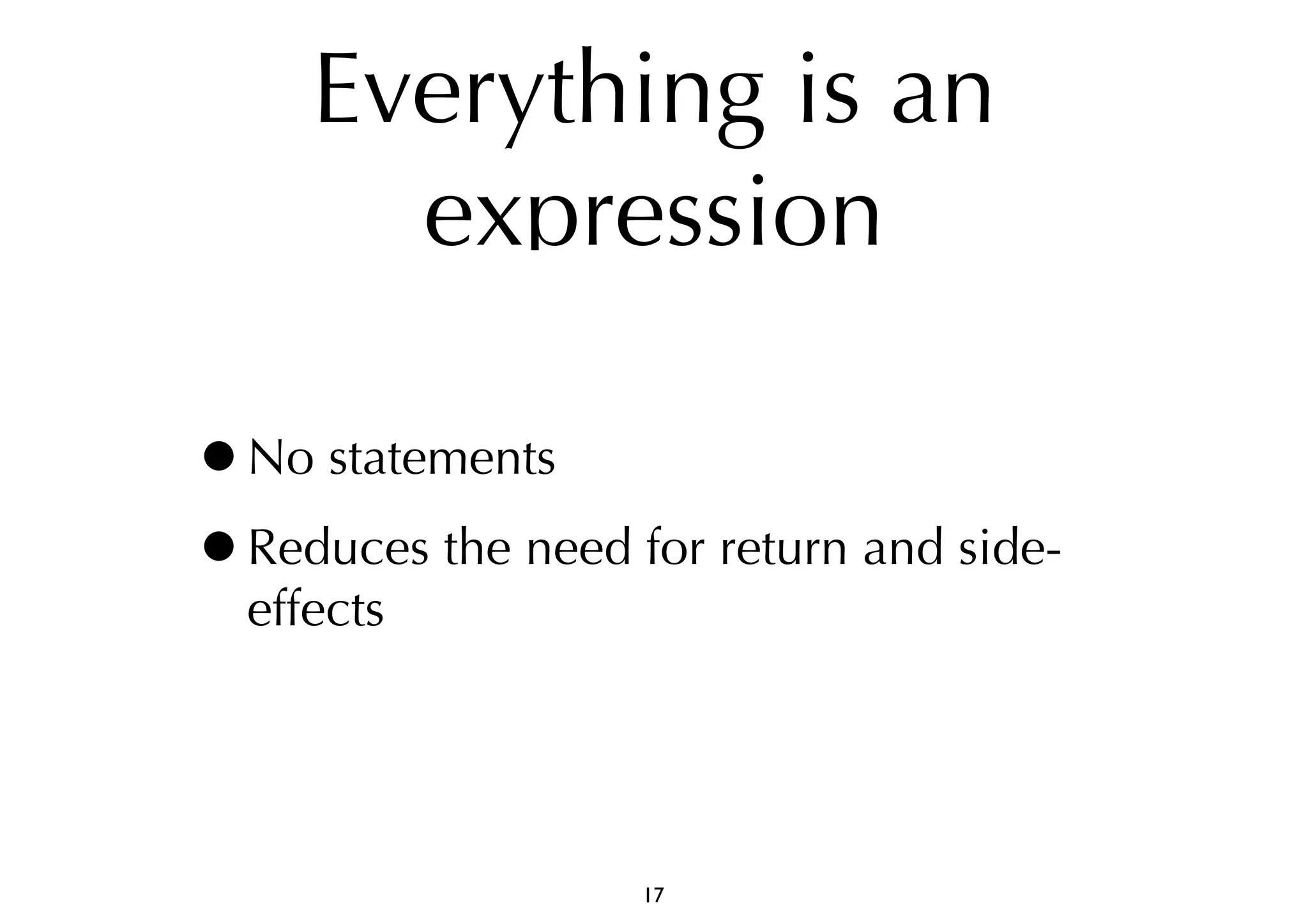
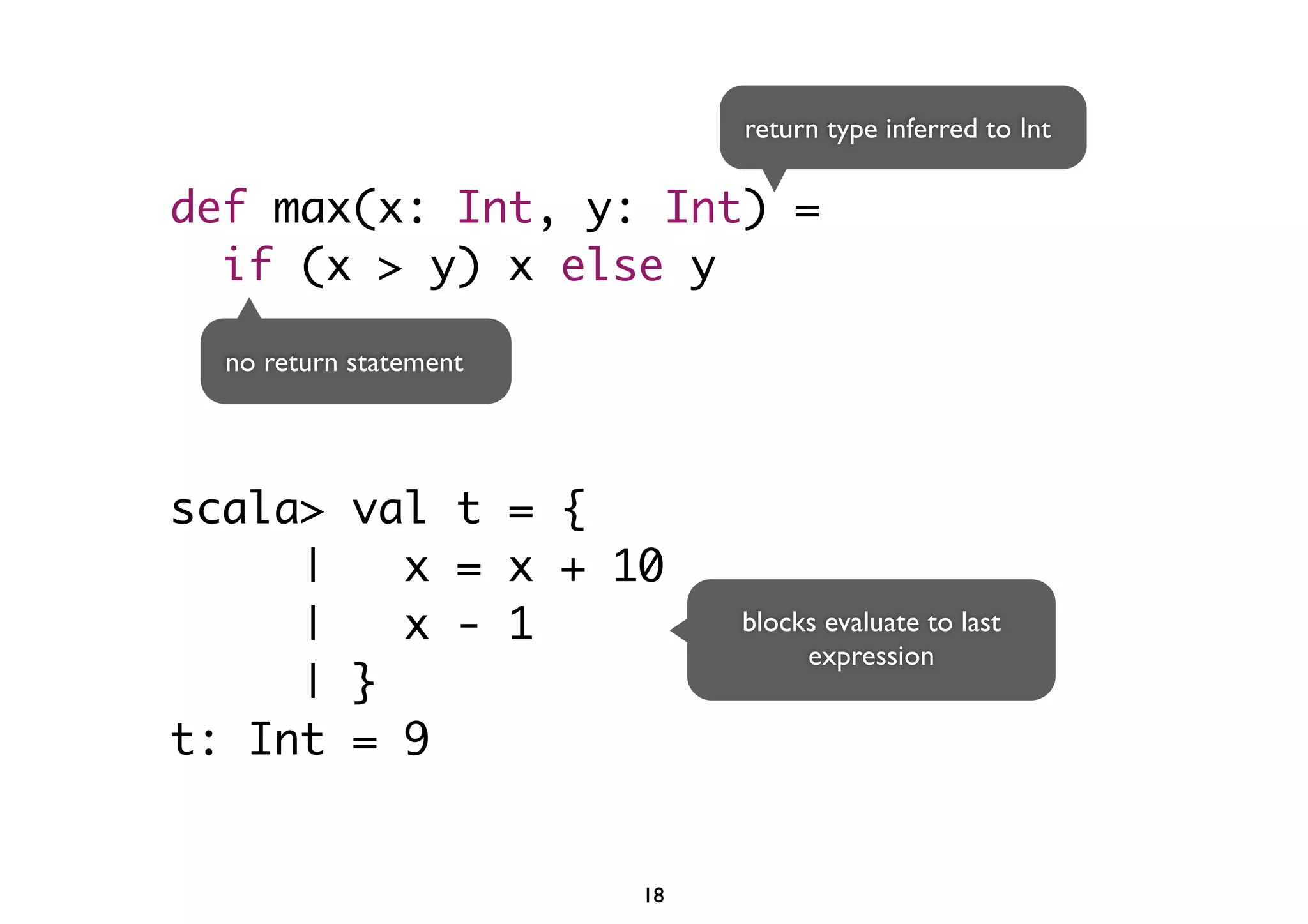
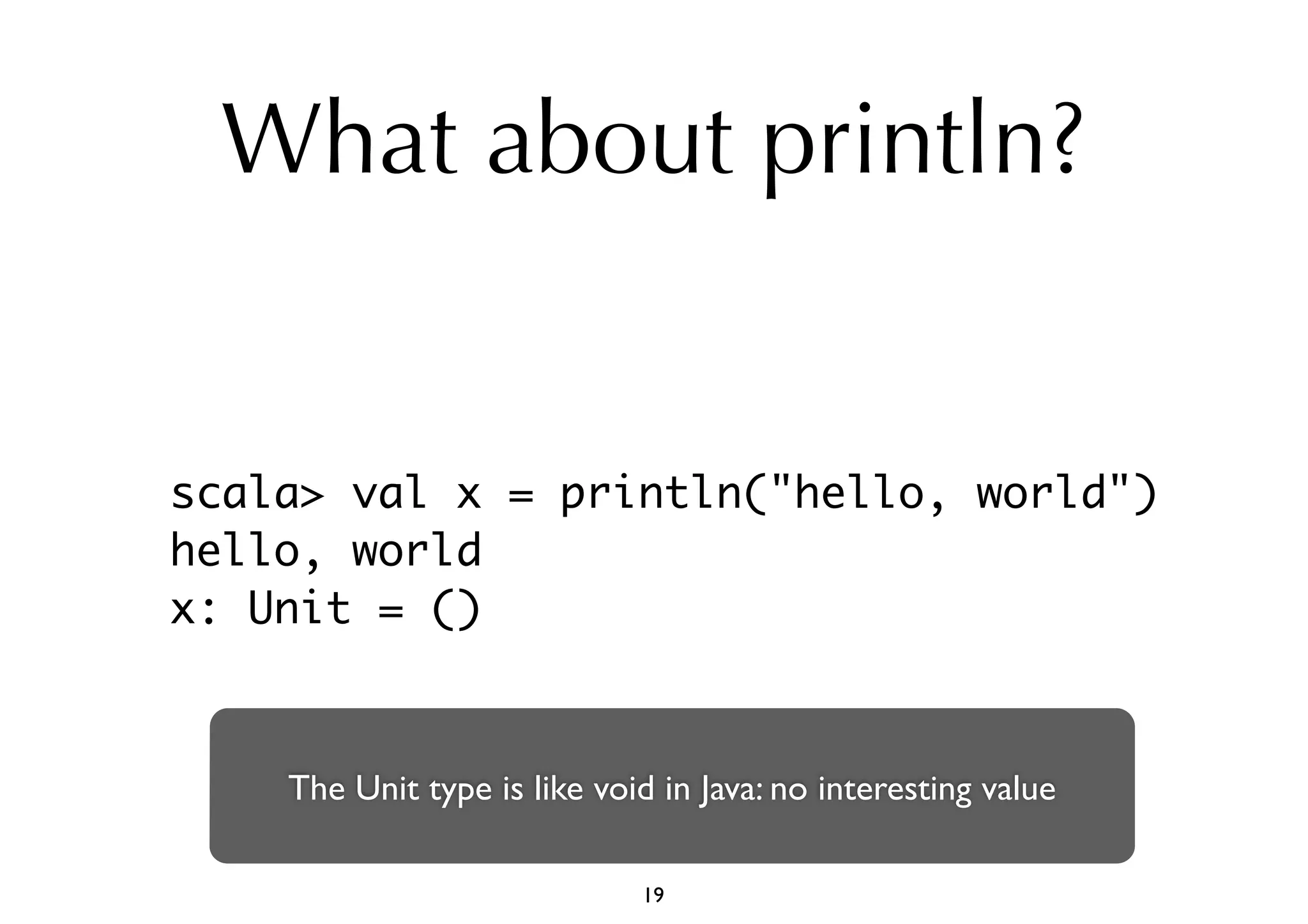
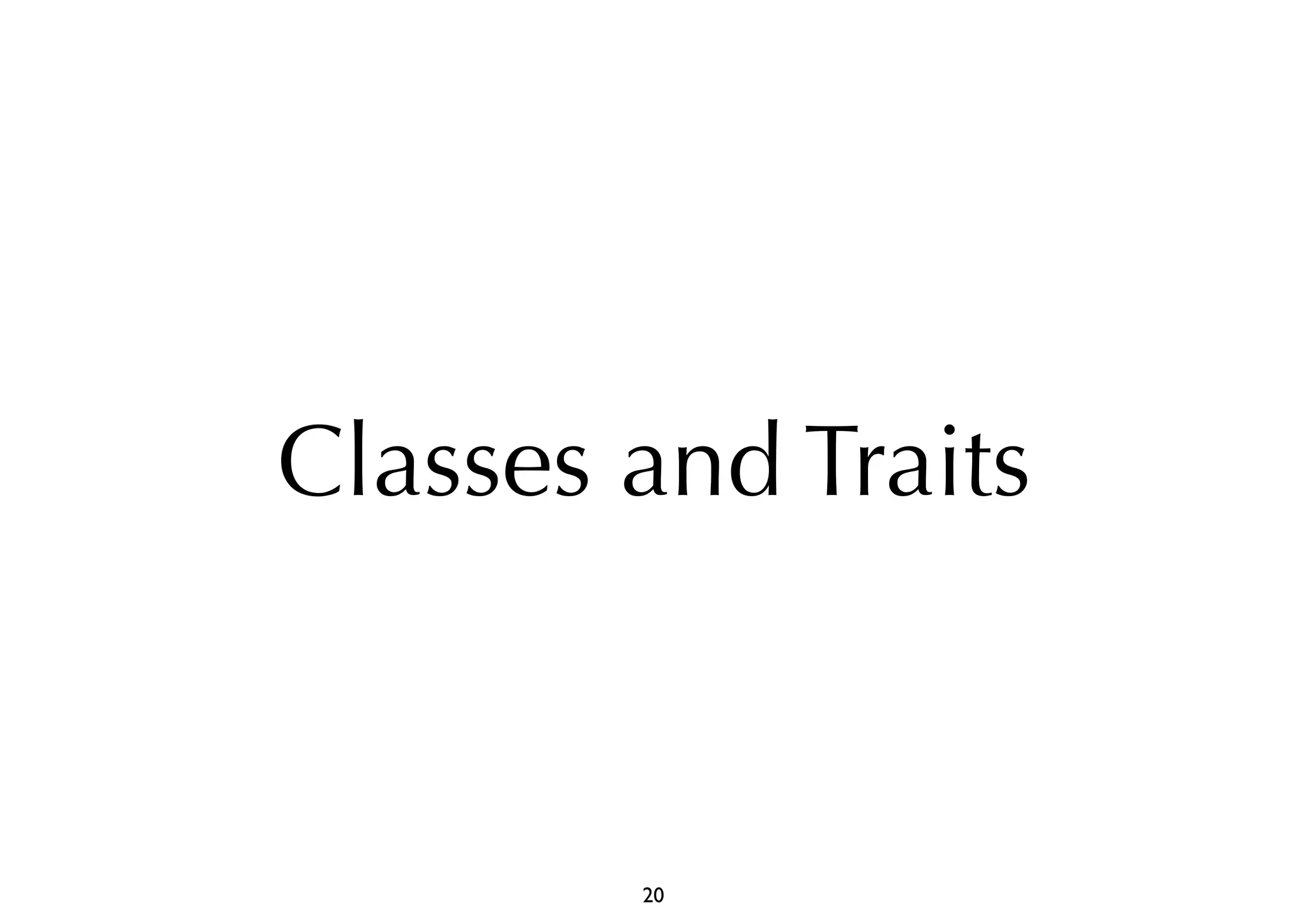
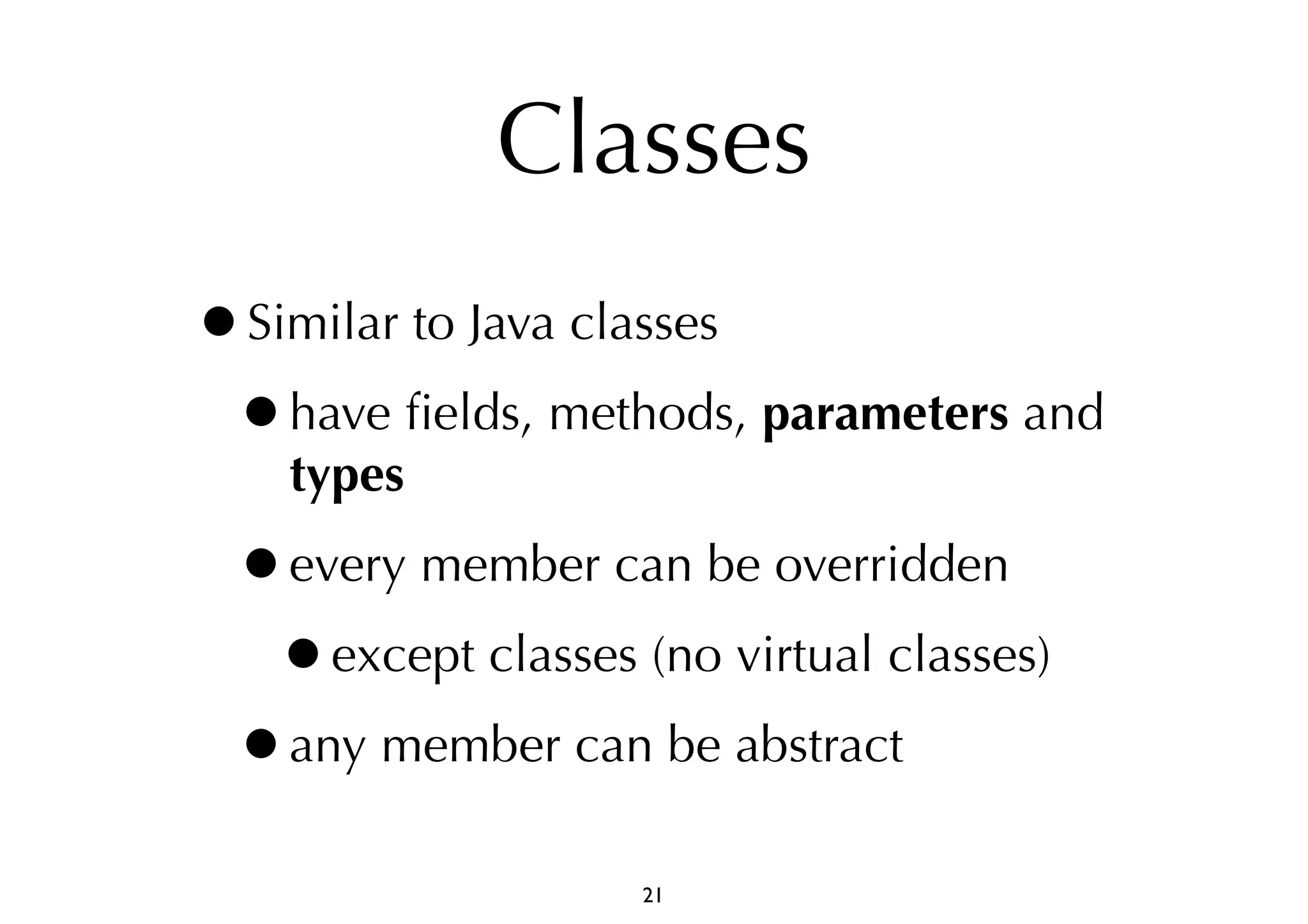

extends List(v, next) {
val cache: Int
def first: T
def children = List(next)
override def toString = "Node " + v
}
22
super ctor call
When compiled, this class will look and behave exactly like the
obvious translation to a Java class. No glue code necessary.](https://image.slidesharecdn.com/scalaintroidragos-141117184923-conversion-gate01/75/Scala-Object-Oriented-Meets-Functional-by-Iulian-Dragos-21-2048.jpg)
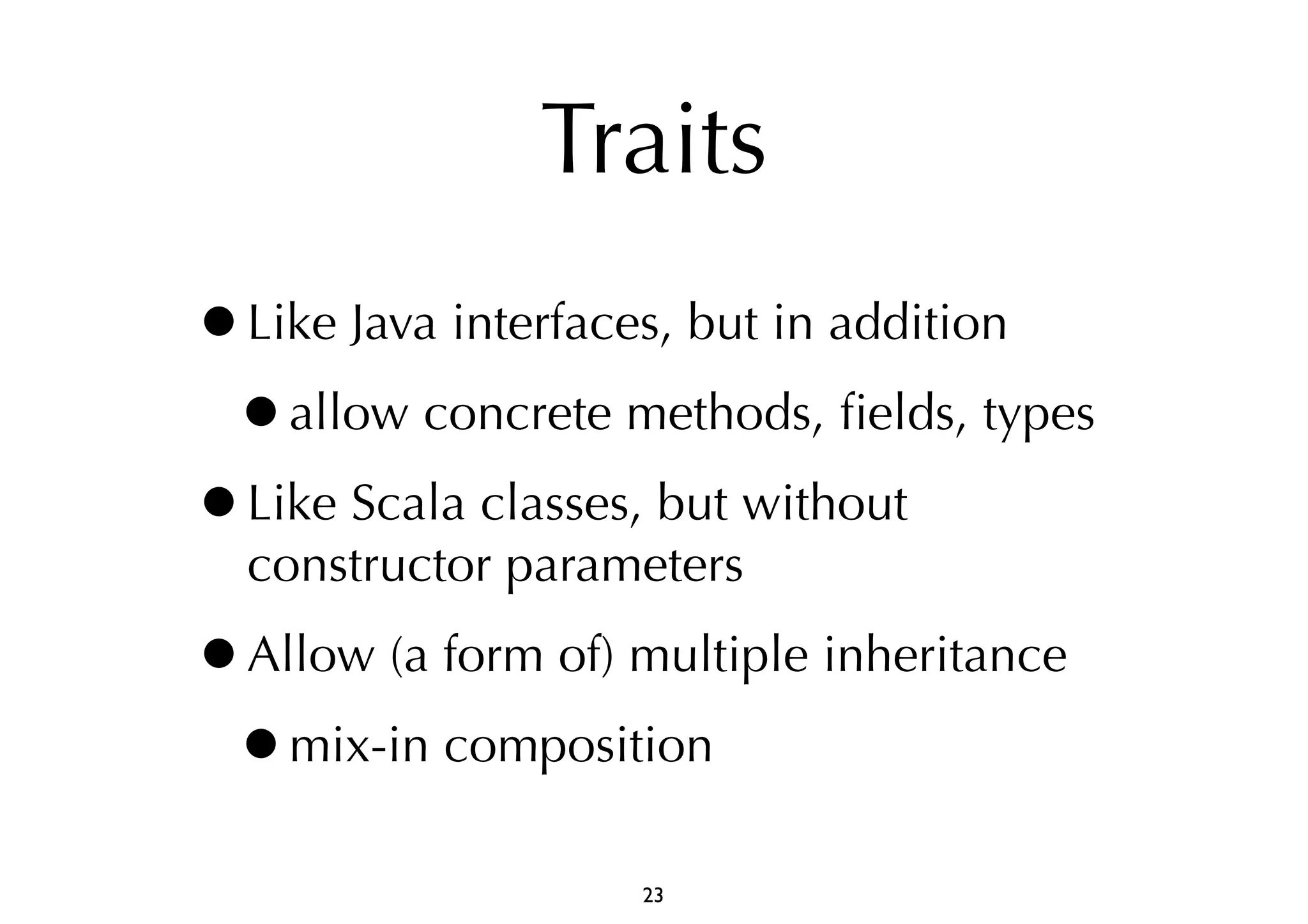
![type parameter can extend Java classes
trait Ordered[A] extends java.lang.Comparable[A] {
def compare(that: A): Int
def < (that: A): Boolean = (this compare that) < 0
def > (that: A): Boolean = (this compare that) > 0
def <= (that: A): Boolean = (this compare that) <= 0
def >= (that: A): Boolean = (this compare that) >= 0
}
classes mixing in Ordered will get all these methods ‘for free’
class Complex extends Ordered[Complex] {
def compare(that: Complex): Int = ...
}
24](https://image.slidesharecdn.com/scalaintroidragos-141117184923-conversion-gate01/75/Scala-Object-Oriented-Meets-Functional-by-Iulian-Dragos-23-2048.jpg)
![if (c1 > c2) c1 else c2
val xs: List[Complex]
xs.sorted
25](https://image.slidesharecdn.com/scalaintroidragos-141117184923-conversion-gate01/75/Scala-Object-Oriented-Meets-Functional-by-Iulian-Dragos-24-2048.jpg)
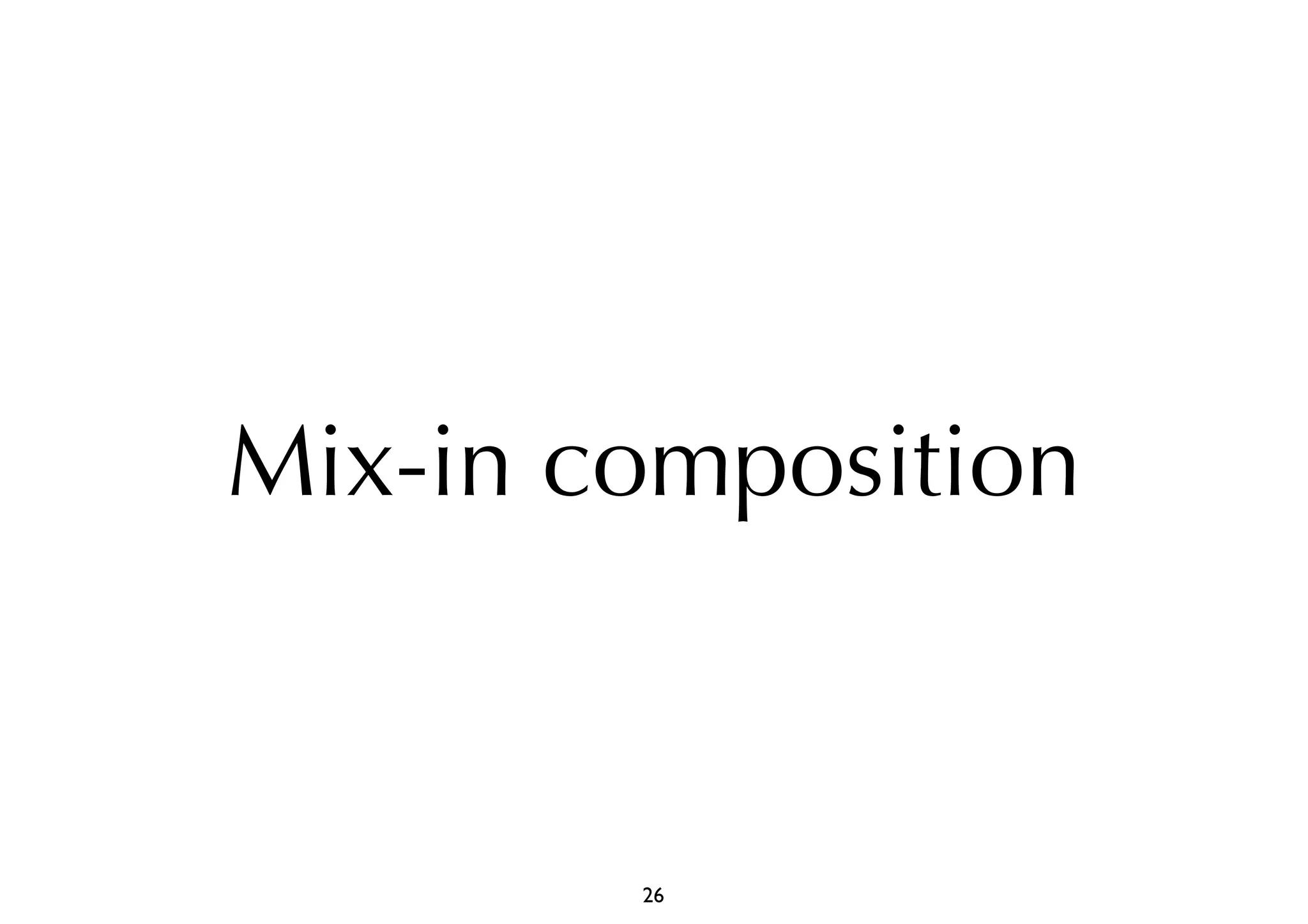
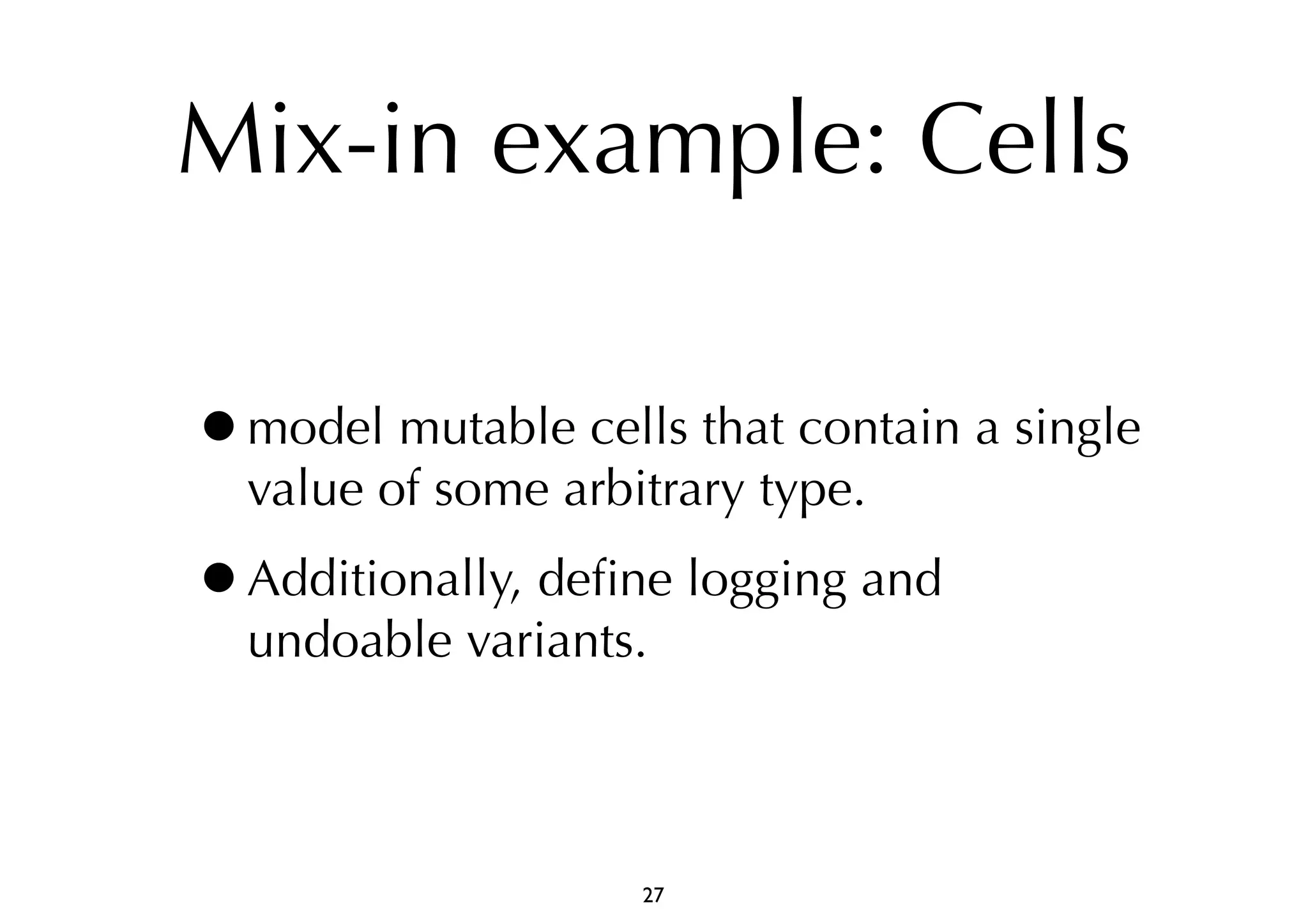
 {
private var v = init
def get(): T = v
def set(v1: T): Unit = { v = v1 }
override def toString: String =
"Cell("+ v +")"
}
make init available as a field
mutable field
28](https://image.slidesharecdn.com/scalaintroidragos-141117184923-conversion-gate01/75/Scala-Object-Oriented-Meets-Functional-by-Iulian-Dragos-27-2048.jpg)
![A trait for undoable cells
trait UndoableCell[T] extends Cell[T] {
import mutable.ArrayStack
private var hist = new ArrayStack[T]()
override def set(v1: T): Unit = {
hist.push(super.get())
super.set(v1)
}
def undo(): Unit =
super.set(hist pop)
}
29](https://image.slidesharecdn.com/scalaintroidragos-141117184923-conversion-gate01/75/Scala-Object-Oriented-Meets-Functional-by-Iulian-Dragos-28-2048.jpg)
![A trait for logging cells
trait LoggingCell[T] extends Cell[T] {
override def get(): T = {
println("getting "+ this)
super.get()
}
override def set(v1: T): Unit = {
println("setting "+ this +" to "+ v1)
super.set(v1)
}
}
30](https://image.slidesharecdn.com/scalaintroidragos-141117184923-conversion-gate01/75/Scala-Object-Oriented-Meets-Functional-by-Iulian-Dragos-29-2048.jpg)
![Mix-in composition
new Cell(0)
new Cell(0)
with LoggingCell[Int]
new Cell(0)
with LoggingCell[Int]
with UndoableCell[Int]
new Cell(0)
with UndoableCell[Int]
with LoggingCell[Int]
cell with logging
cell with logging
and undoing
cell with undoing
and logging
31](https://image.slidesharecdn.com/scalaintroidragos-141117184923-conversion-gate01/75/Scala-Object-Oriented-Meets-Functional-by-Iulian-Dragos-30-2048.jpg)
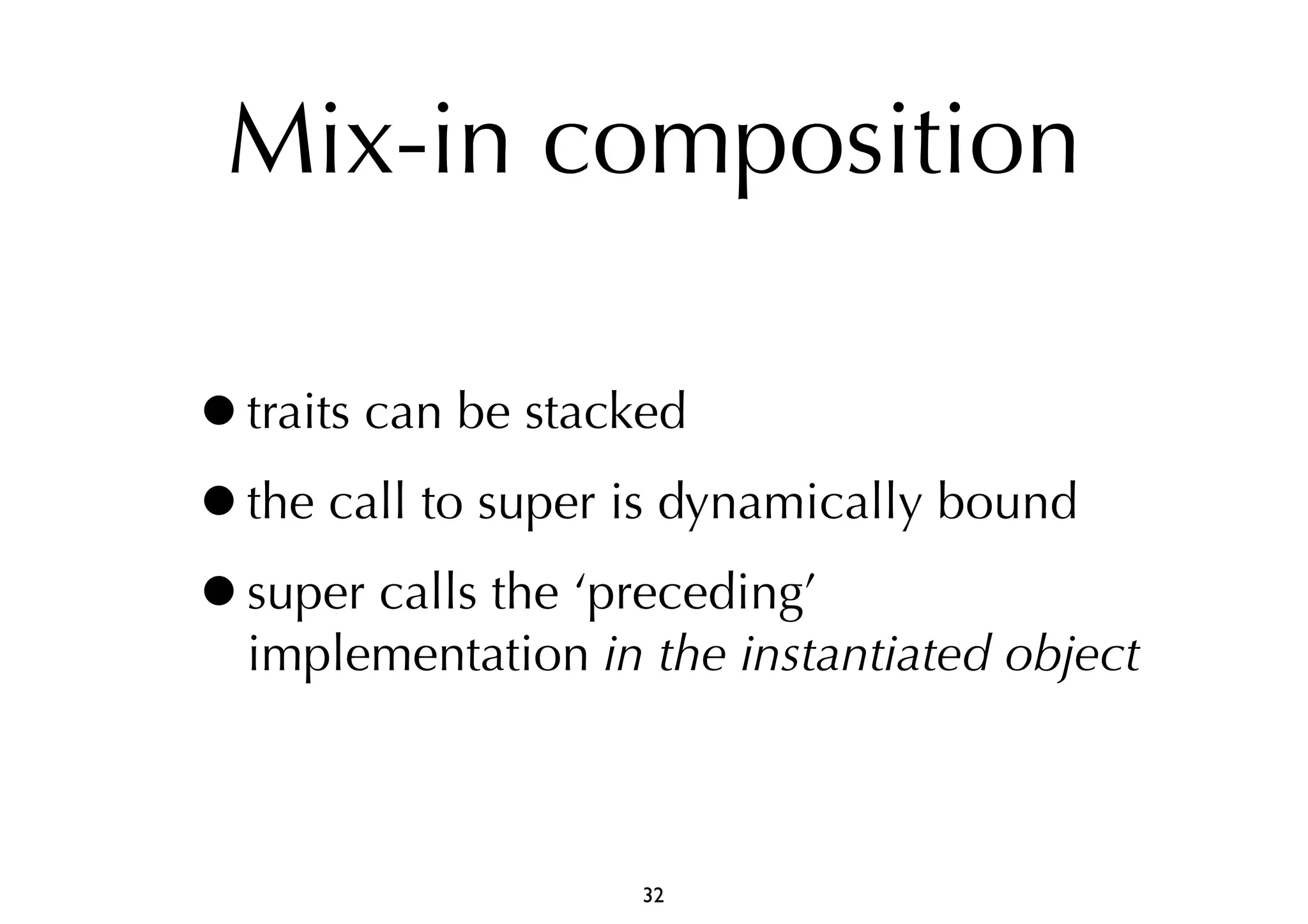
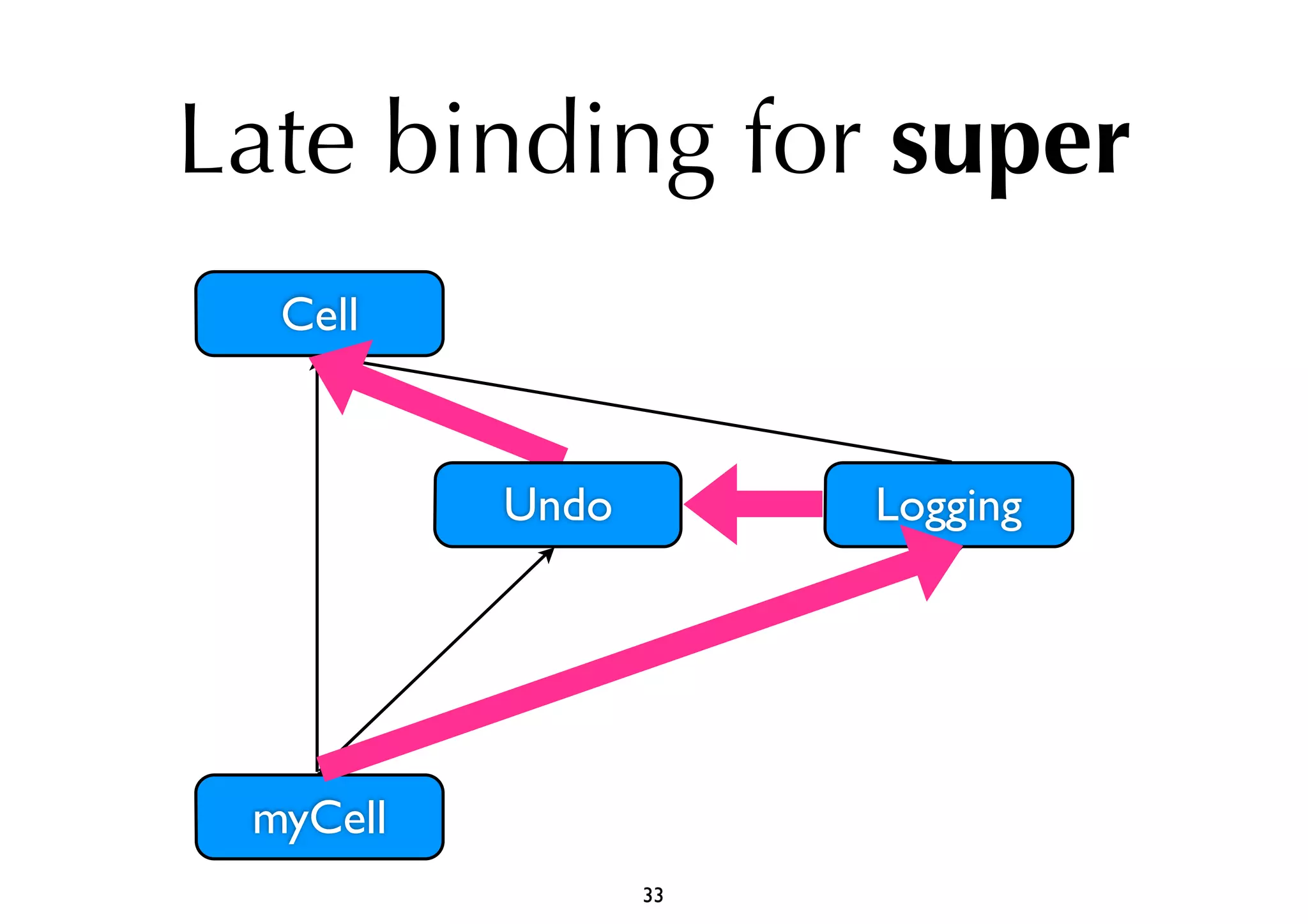
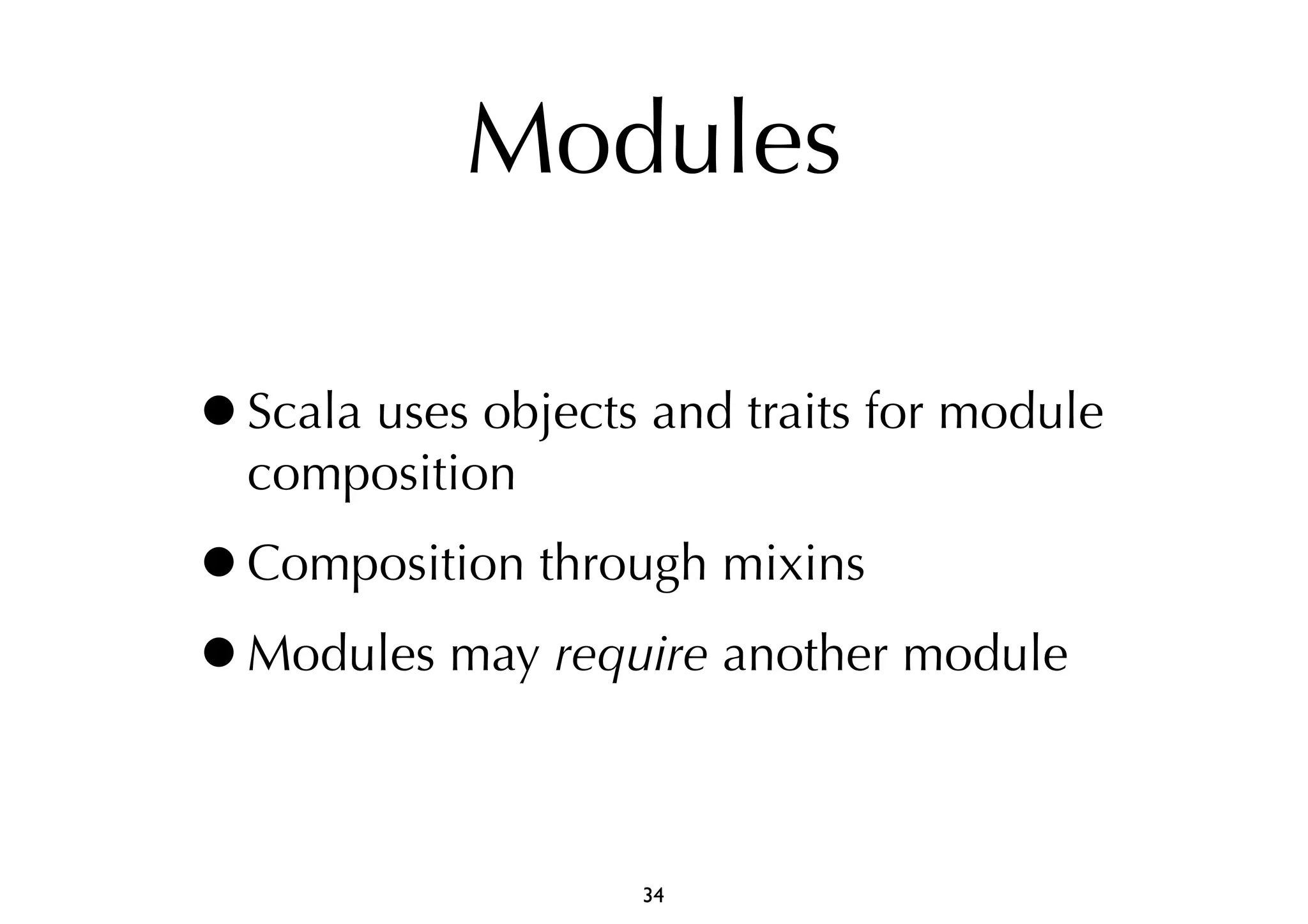
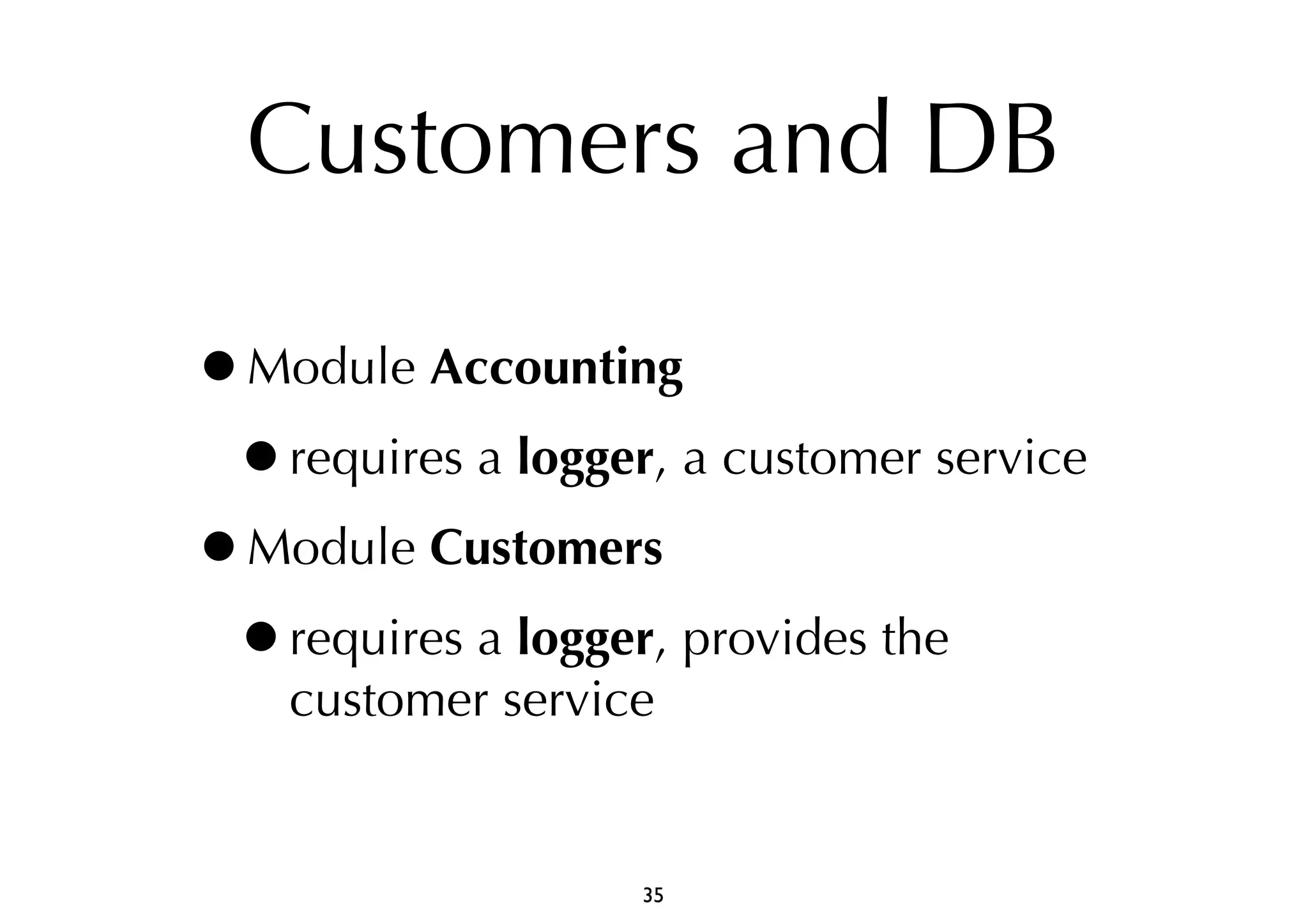
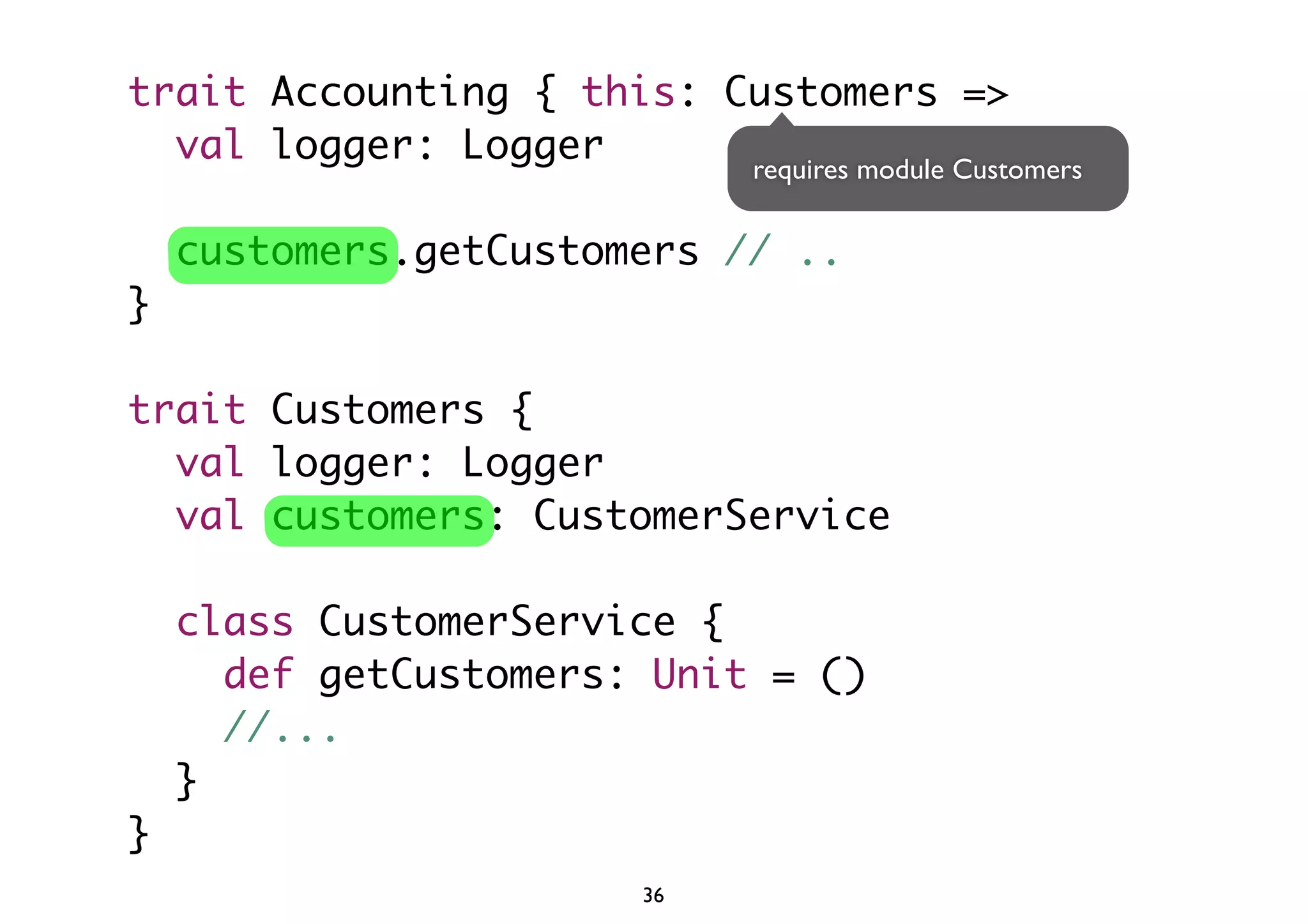
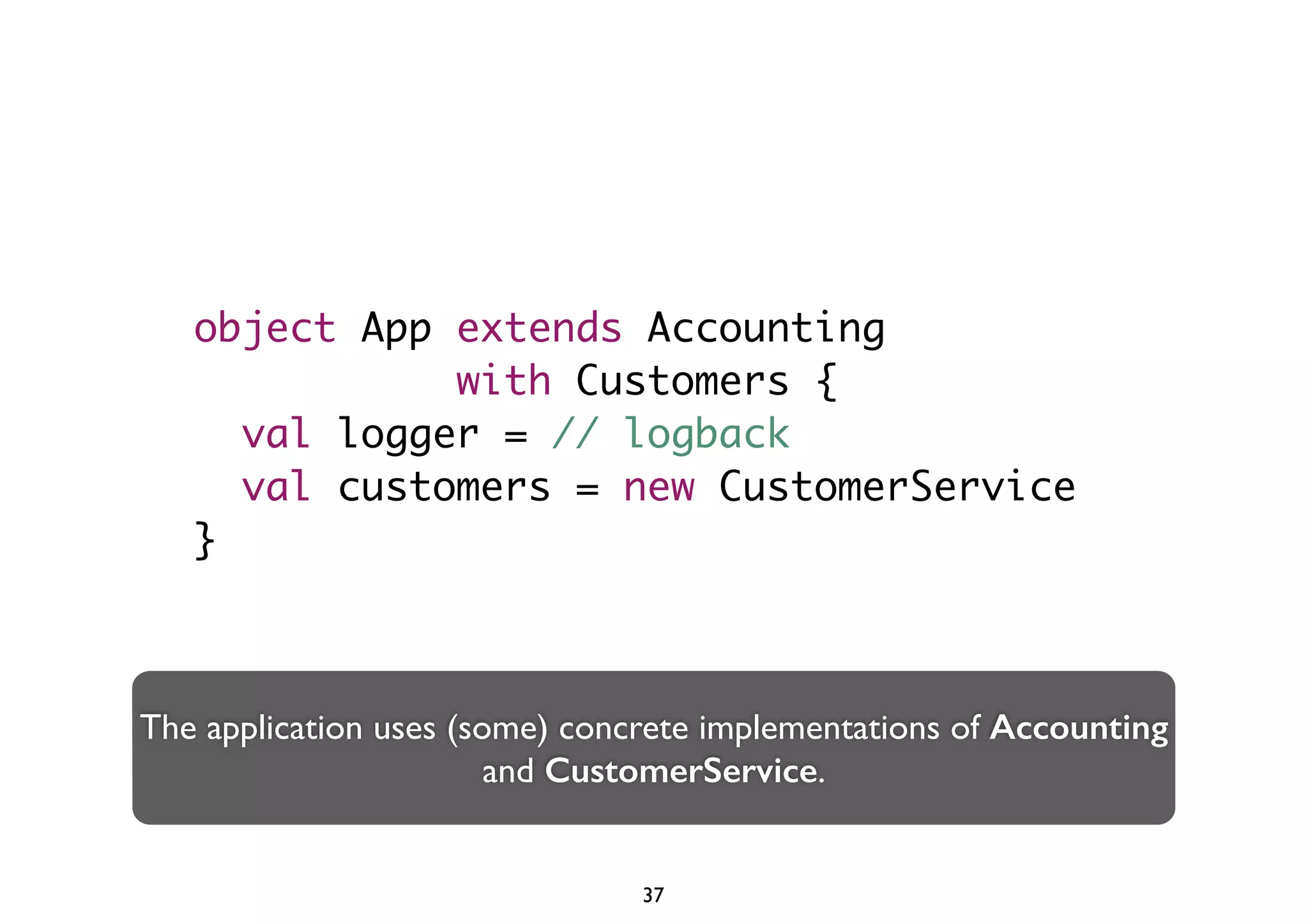
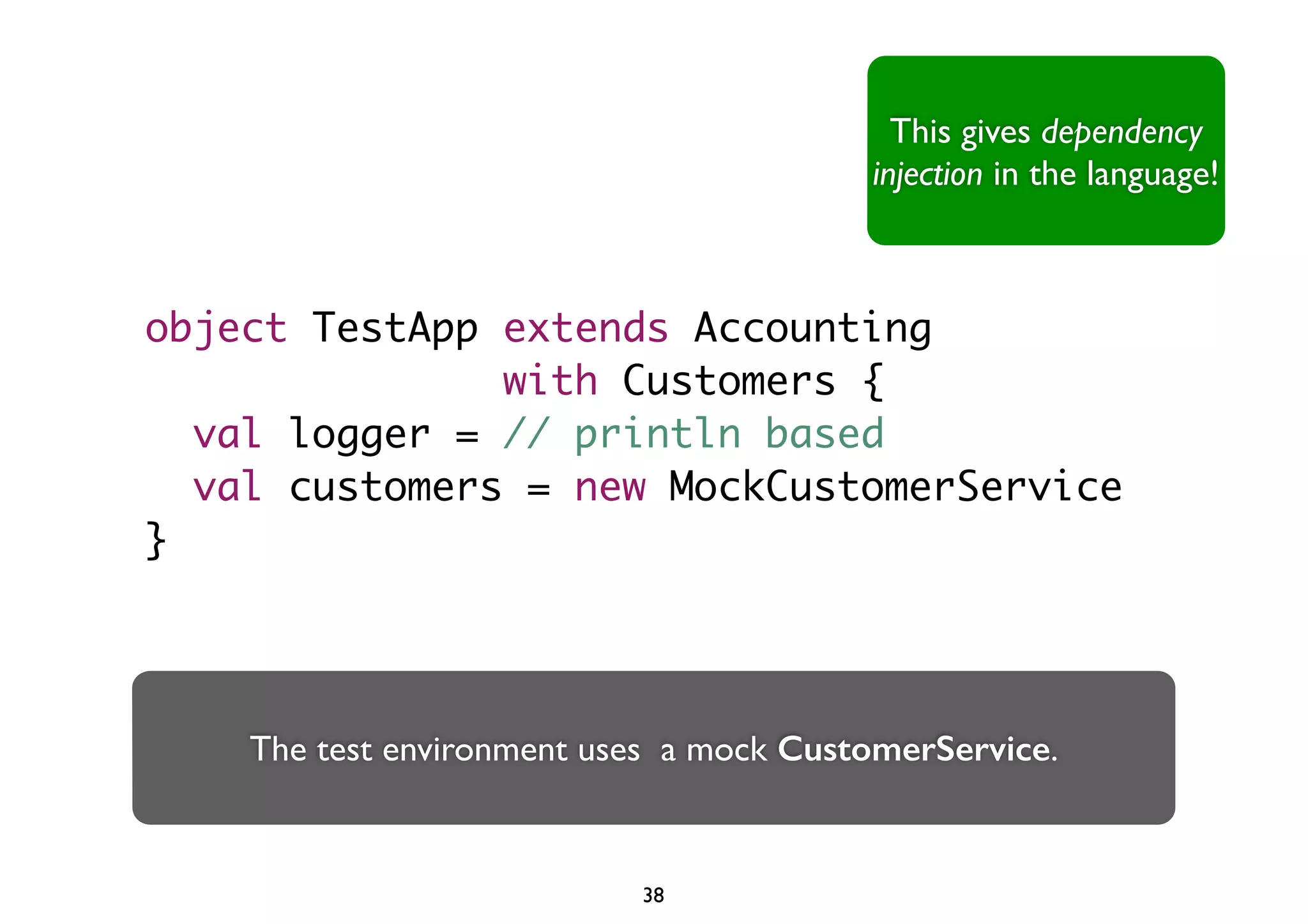
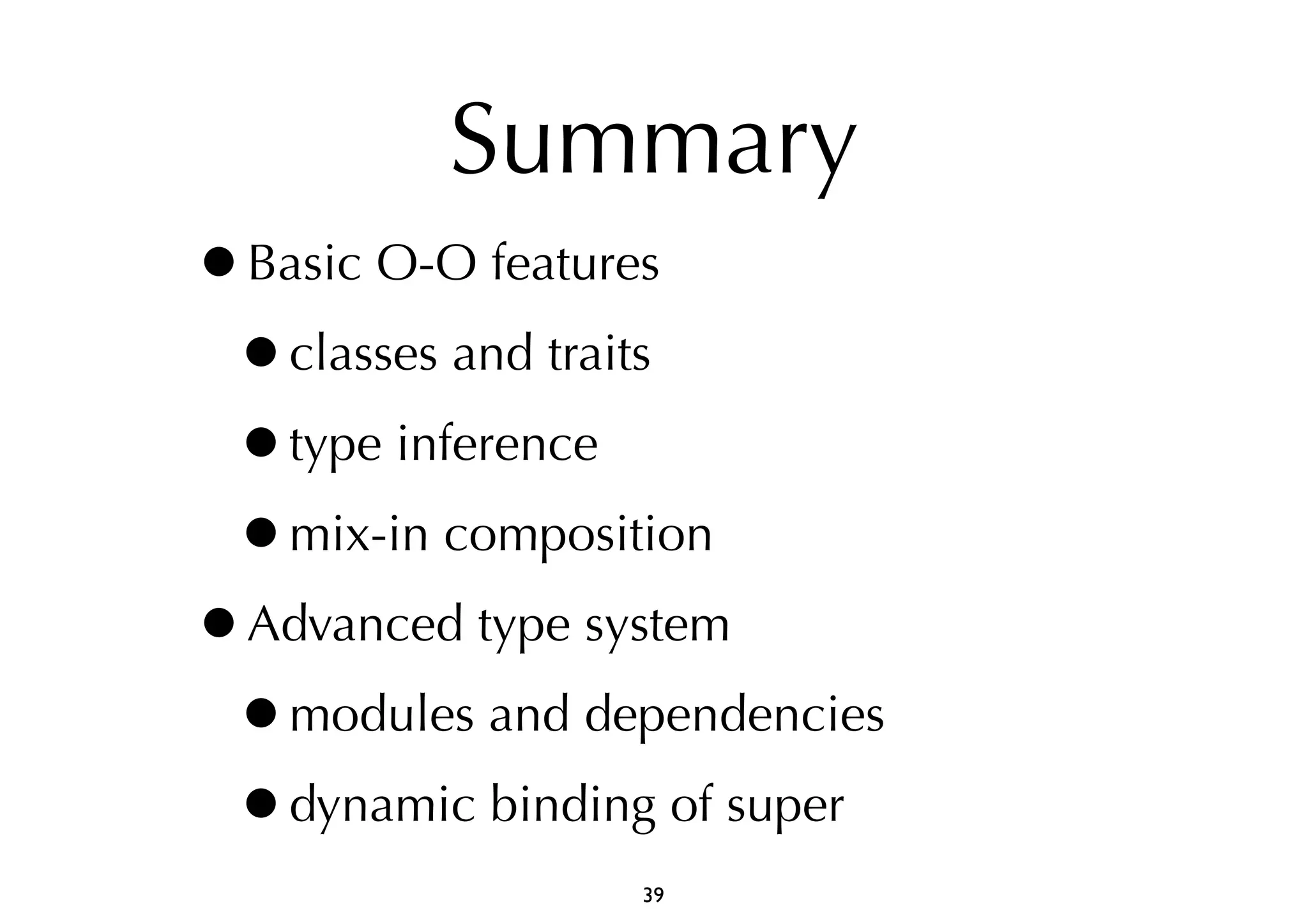
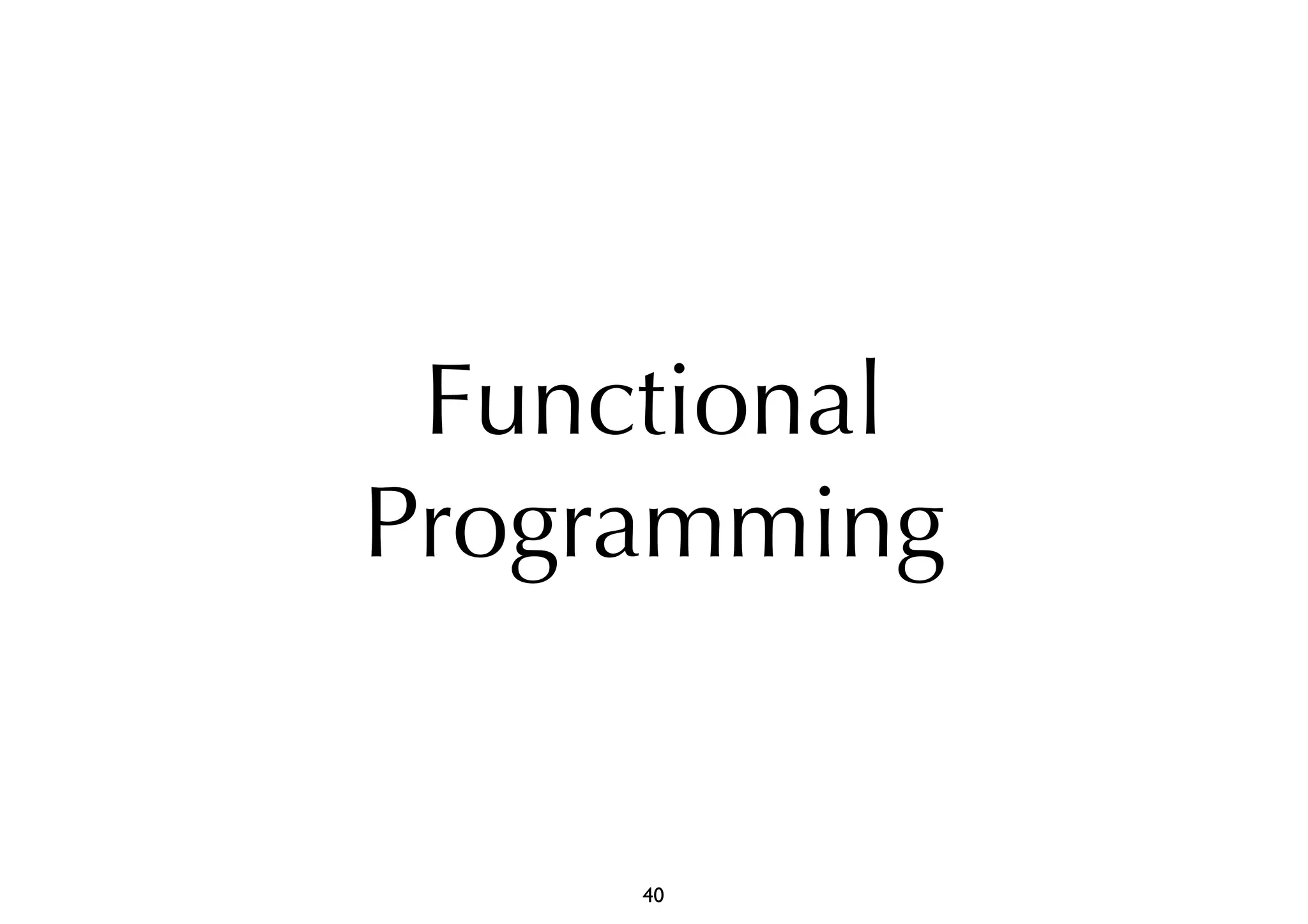
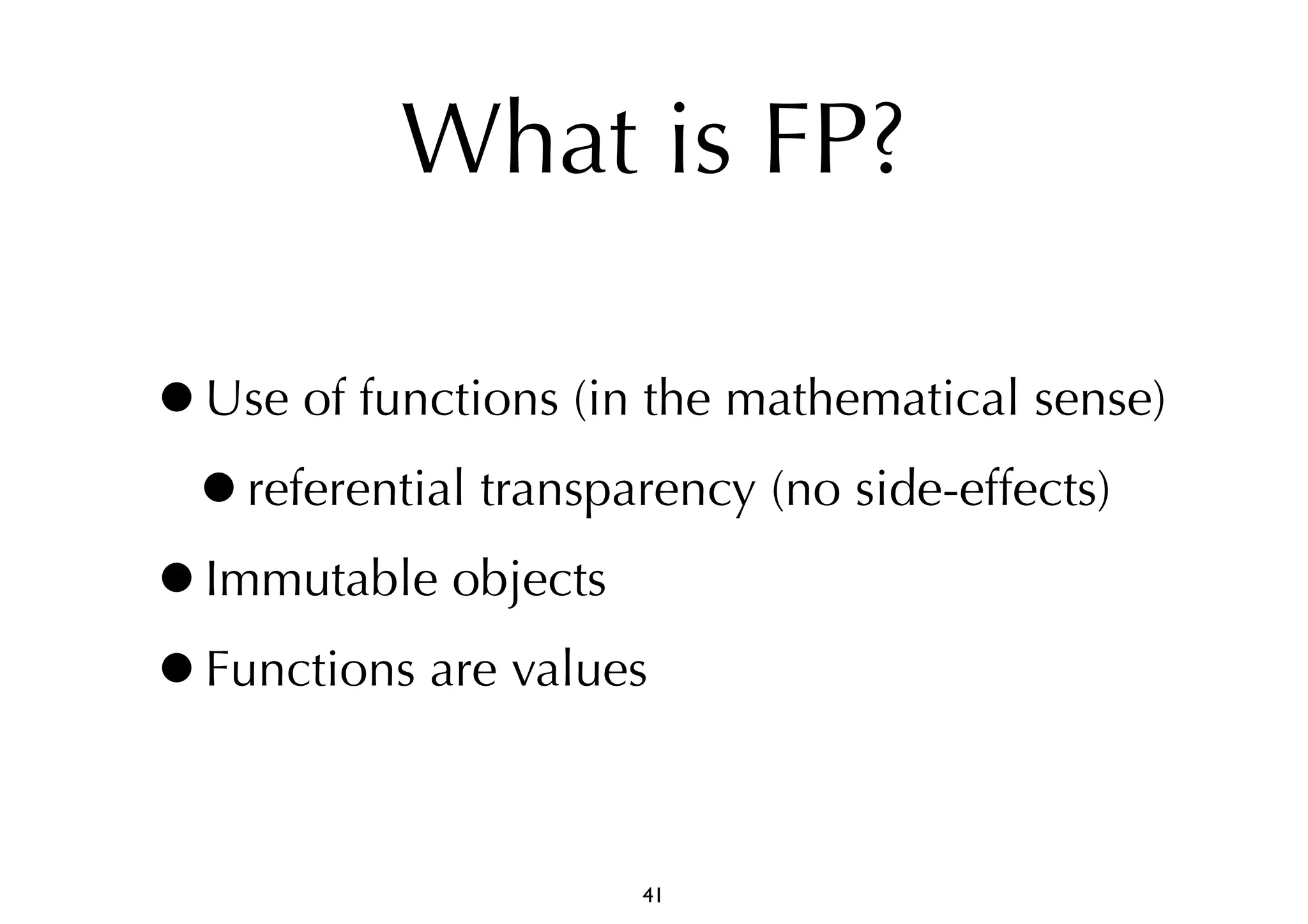
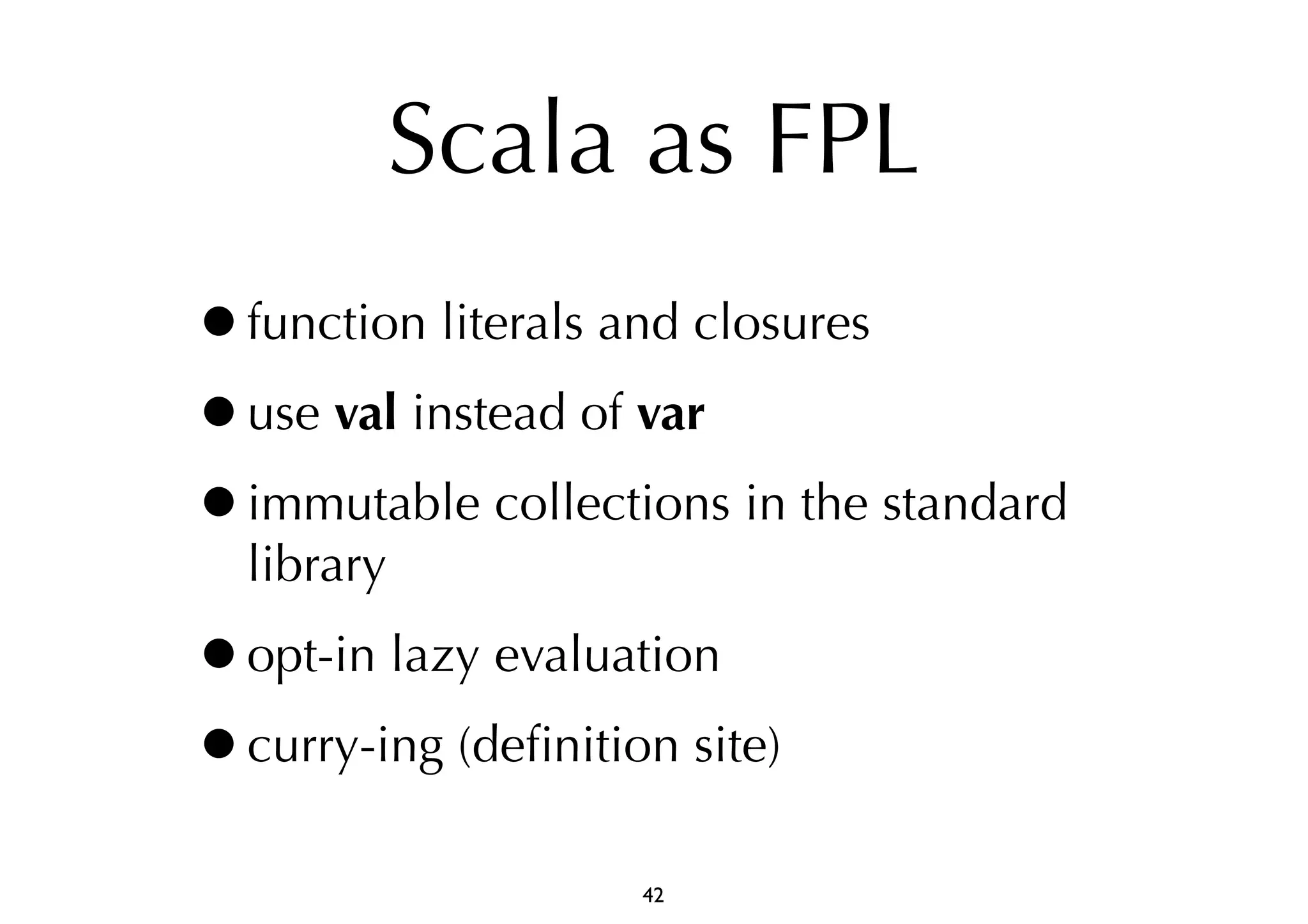
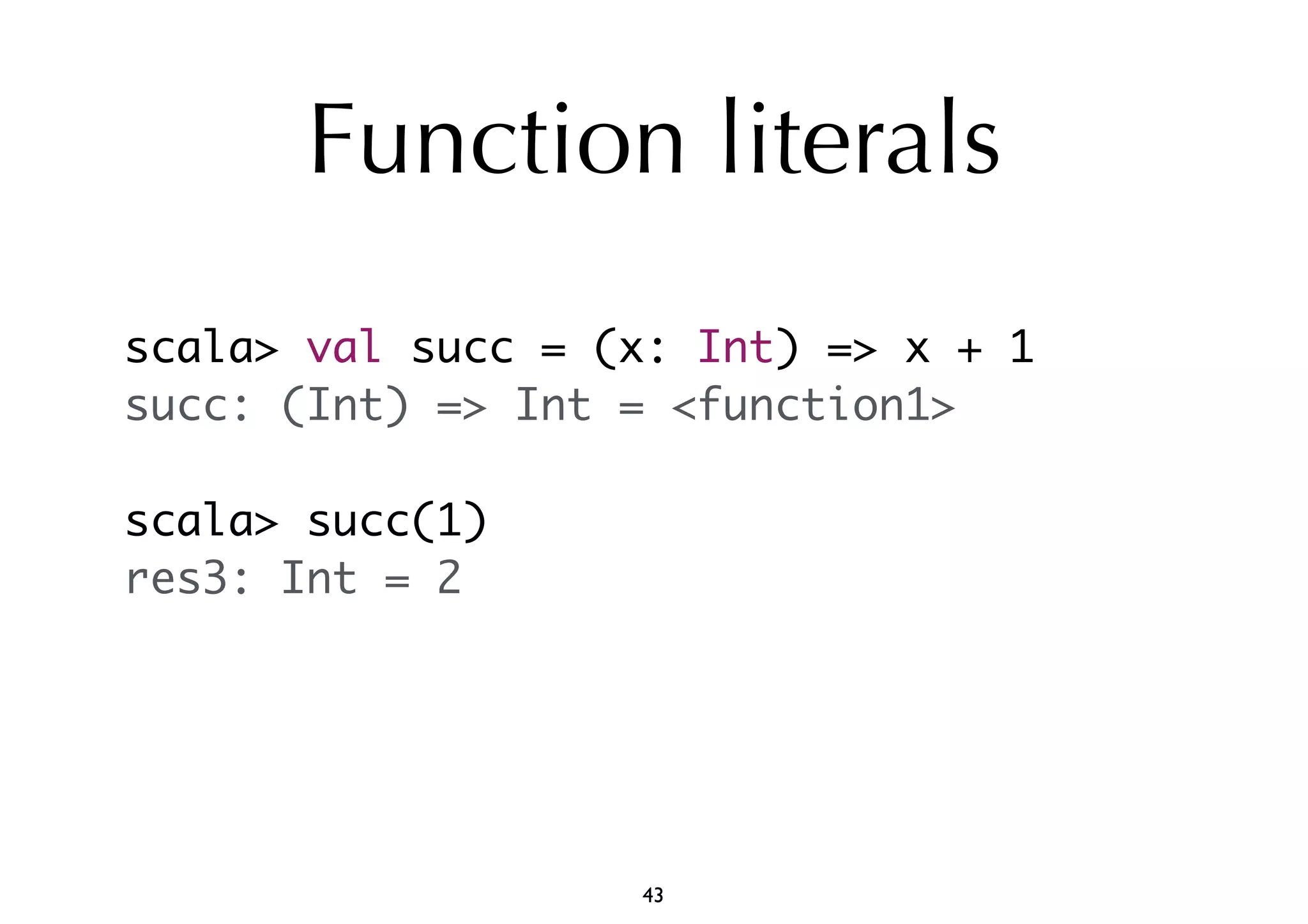
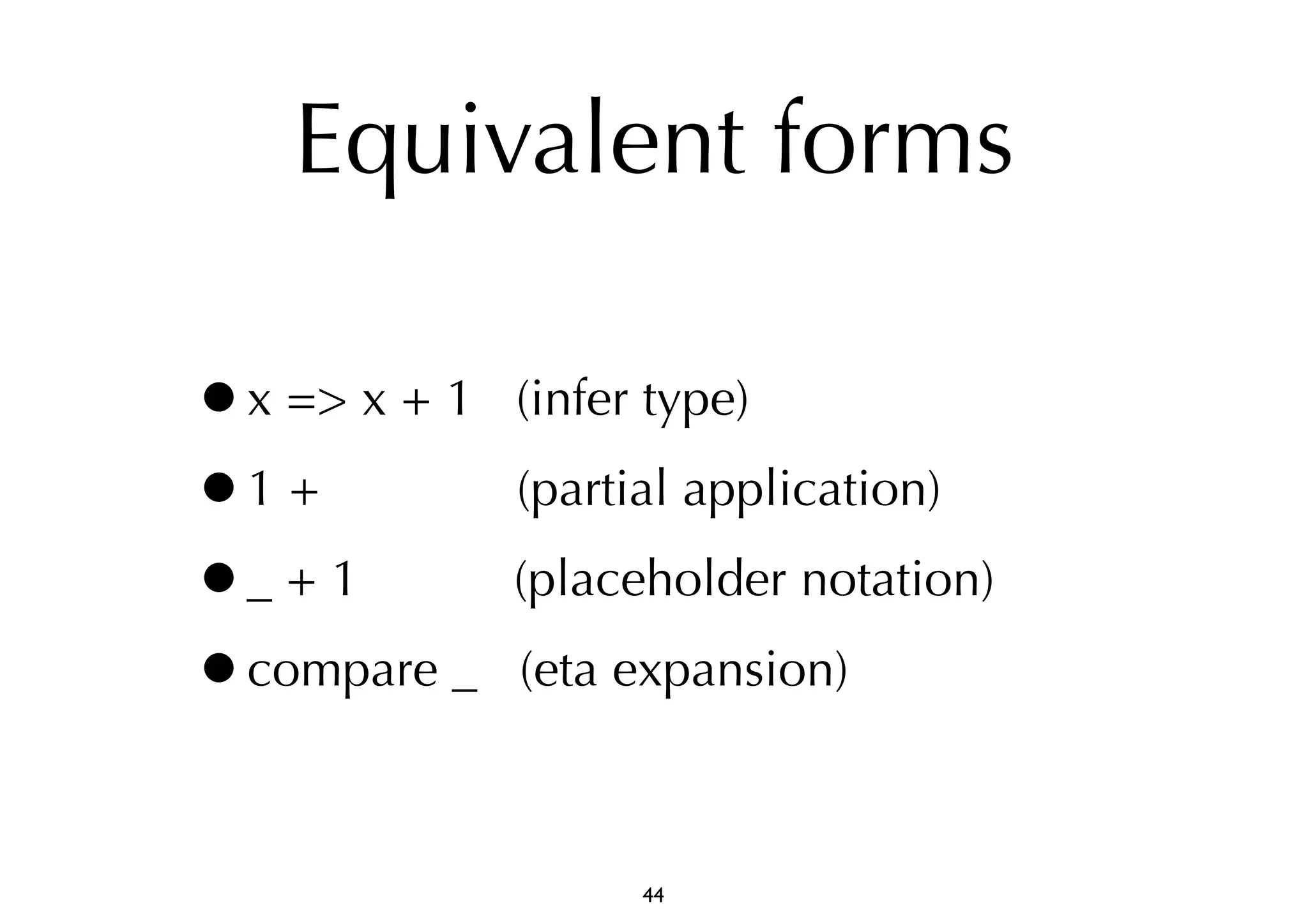
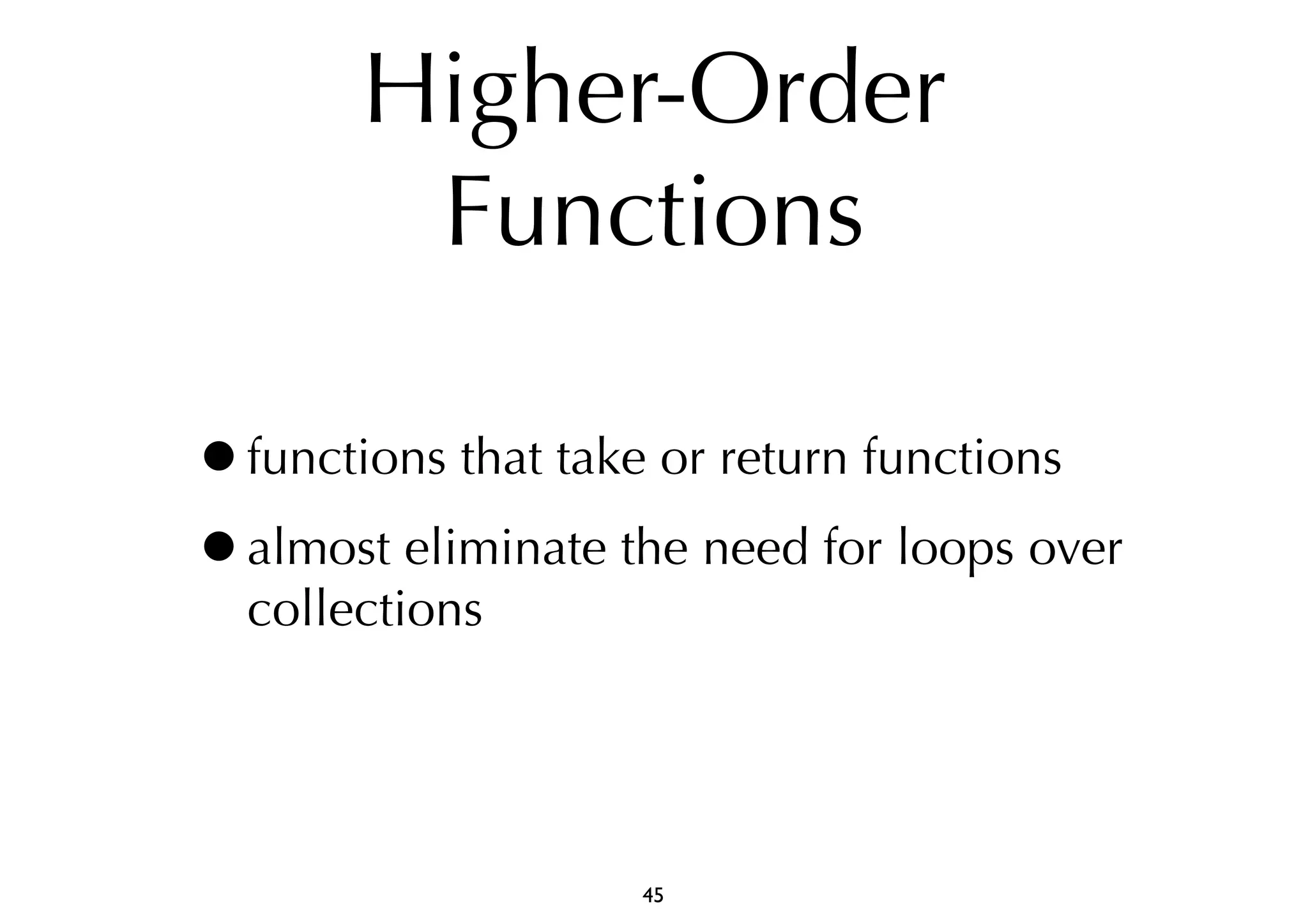
![val xs = List(1, 2, 3, 4, 5)
xs.foreach(println)
scala> xs.forall(_ < 10)
res5: Boolean = true
scala> xs.map(_ * 2)
res6: List[Int] = List(2, 4, 6, 8, 10)
def findBelow(limit: Int) =
persons.filter(_.age < limit)
lexical scoping: functions may refer and
even modify anything in scope
46](https://image.slidesharecdn.com/scalaintroidragos-141117184923-conversion-gate01/75/Scala-Object-Oriented-Meets-Functional-by-Iulian-Dragos-45-2048.jpg)
![Everything is an object
•Closures are objects as well
•(compiler generated) instances of trait
Function1[A, B]
trait Function1[R, A] {
def apply(x: A): R
}
47](https://image.slidesharecdn.com/scalaintroidragos-141117184923-conversion-gate01/75/Scala-Object-Oriented-Meets-Functional-by-Iulian-Dragos-46-2048.jpg)
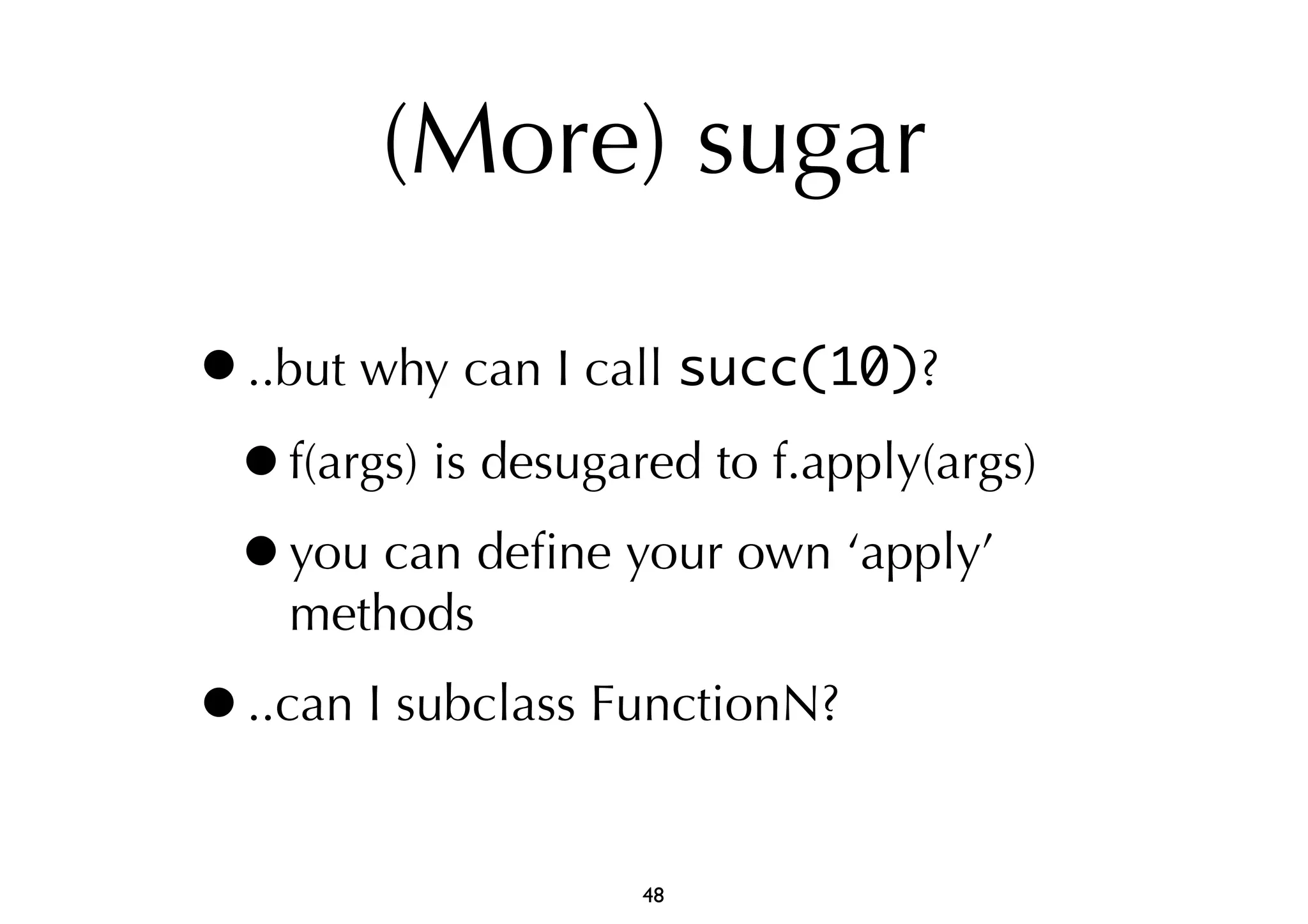
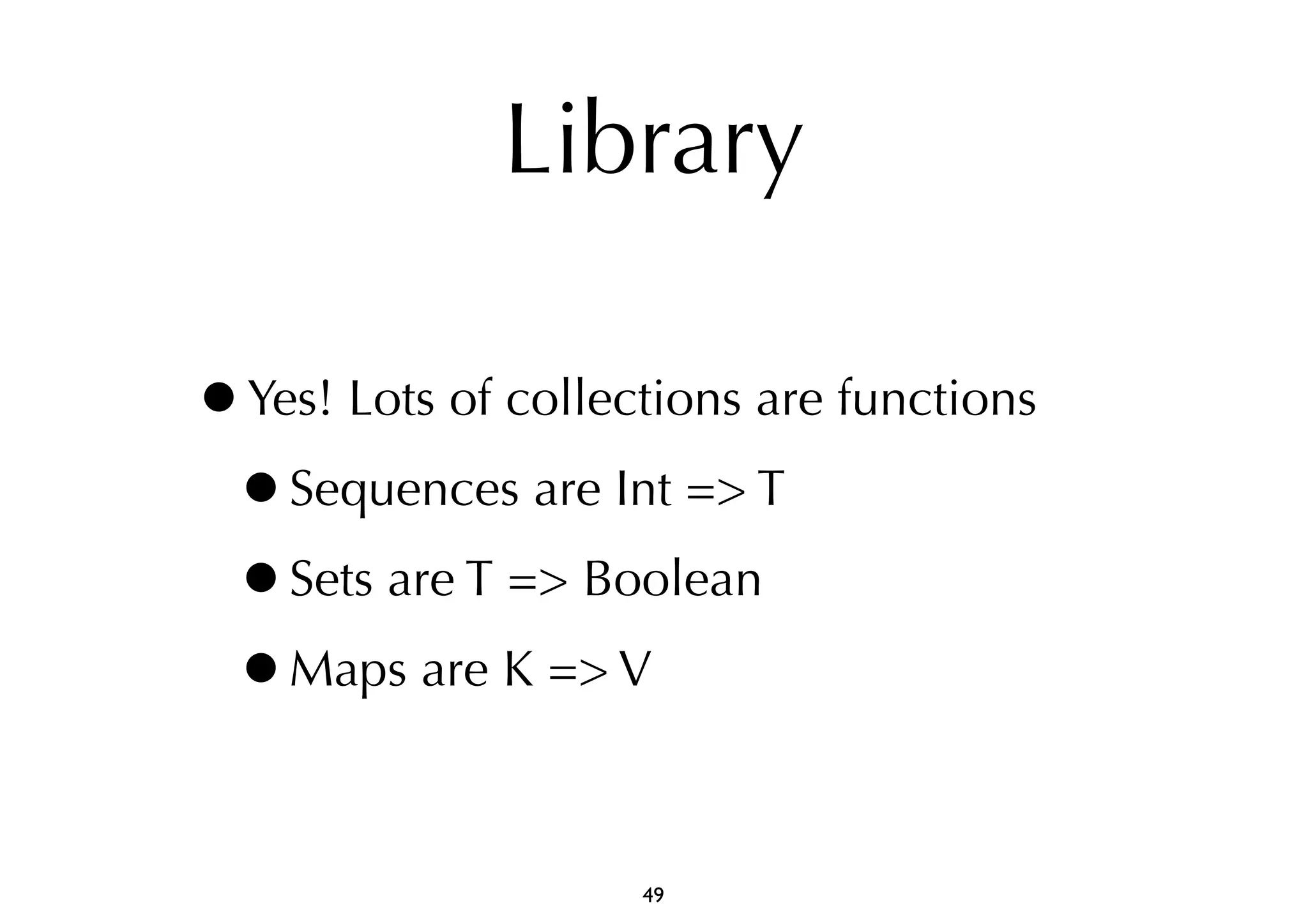

![Collections
•Generic (List[T], Map[K, V])
•Mutable and immutable
implementations (default is immutable)
•Uniform (same method protocol for all
collections)
•Uniform Return Principle
•No compiler magic!
51](https://image.slidesharecdn.com/scalaintroidragos-141117184923-conversion-gate01/75/Scala-Object-Oriented-Meets-Functional-by-Iulian-Dragos-50-2048.jpg)
![Example: Maps
scala> val capitals = Map("France" -> "Paris", "Switzerland" -> "Bern", "Sweden"
-> "Stockholm")
capitals: immutable.Map[String,String] = Map(France -> Paris, Switzerland ->
Bern, Sweden -> Stockholm)
scala> capitals("France")
res7: java.lang.String = Paris
scala> capitals + ("Romania" -> "Bucharest")
res8: immutable.Map[String,String] = Map(France -> Paris, Switzerland -> Bern,
Sweden -> Stockholm, Romania -> Bucharest)
scala> capitals
res9: immutable.Map[String,String] = Map(France -> Paris, Switzerland -> Bern,
Sweden -> Stockholm)
scala> capitals.filter(_._2 == "Paris")
res10: immutable.Map[String,String] = Map(France -> Paris)
52](https://image.slidesharecdn.com/scalaintroidragos-141117184923-conversion-gate01/75/Scala-Object-Oriented-Meets-Functional-by-Iulian-Dragos-51-2048.jpg)
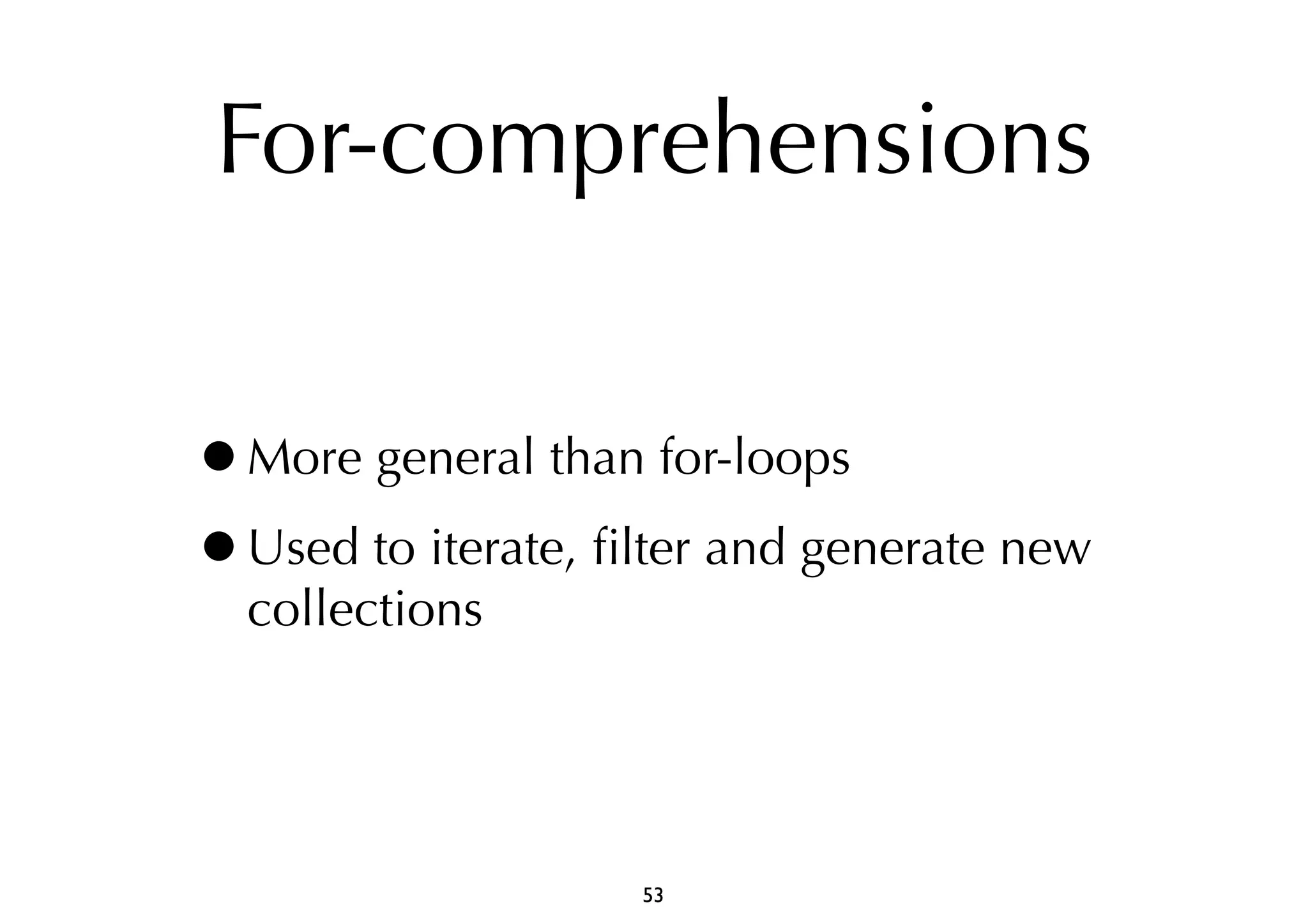
![For-comprehensions
may have any number of generators
p is in scope for other generators
for (p <- persons; pr <- p.projects;
if pr.overdue) yield p.name
guard construct a new collection of the same
type, element by element
res10: List[String] = List(“John”, “Harry”)
54](https://image.slidesharecdn.com/scalaintroidragos-141117184923-conversion-gate01/75/Scala-Object-Oriented-Meets-Functional-by-Iulian-Dragos-53-2048.jpg)
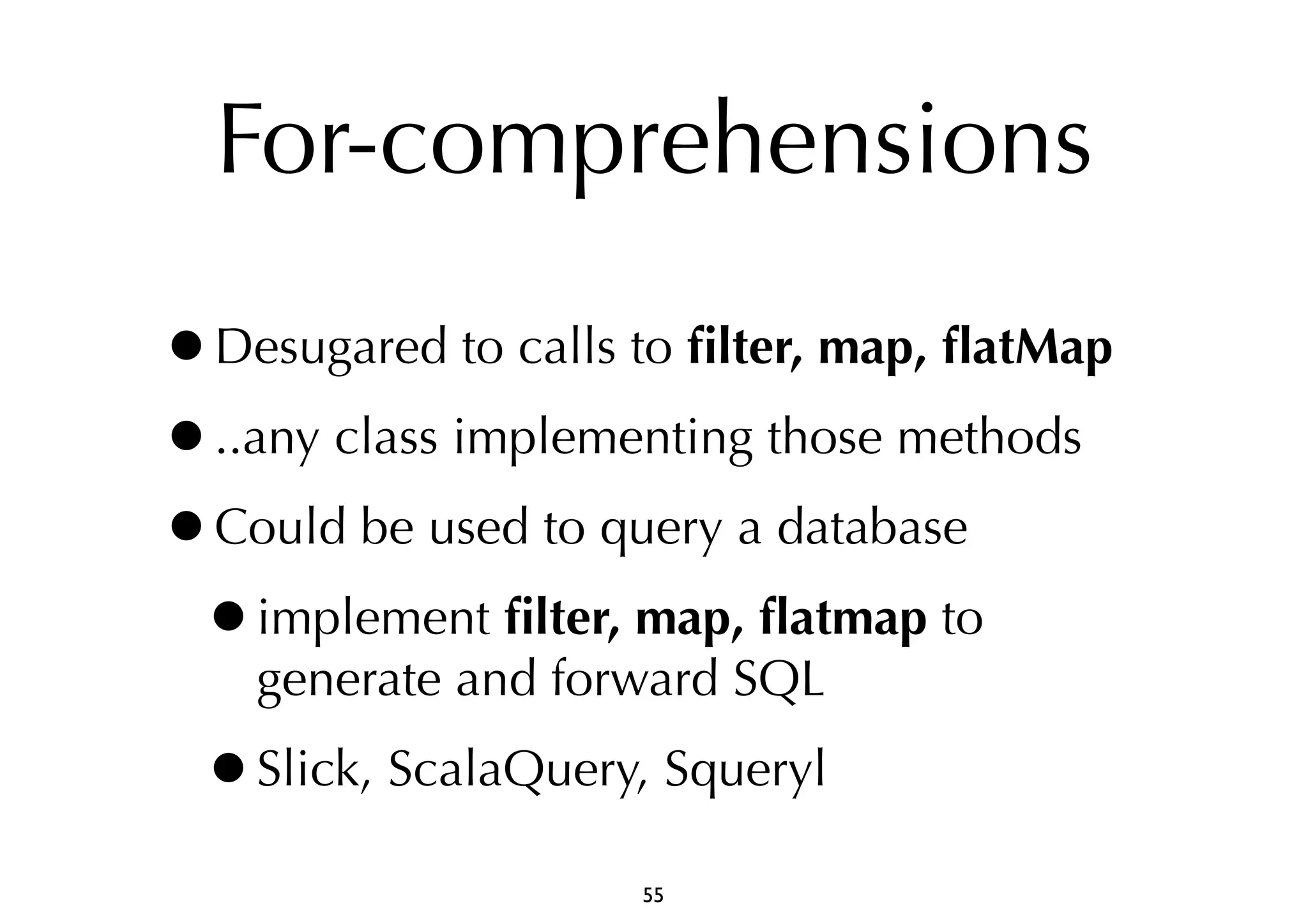
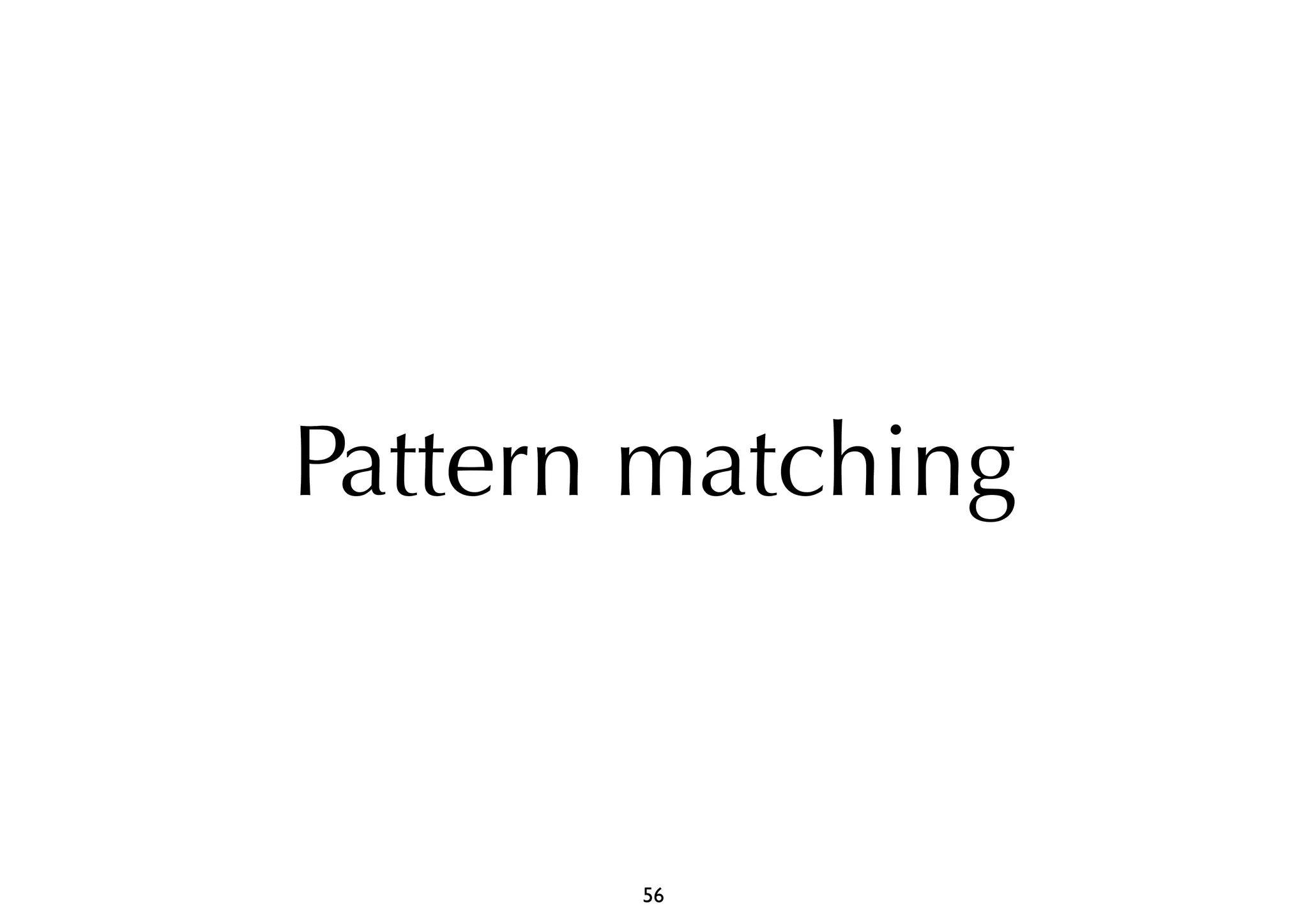
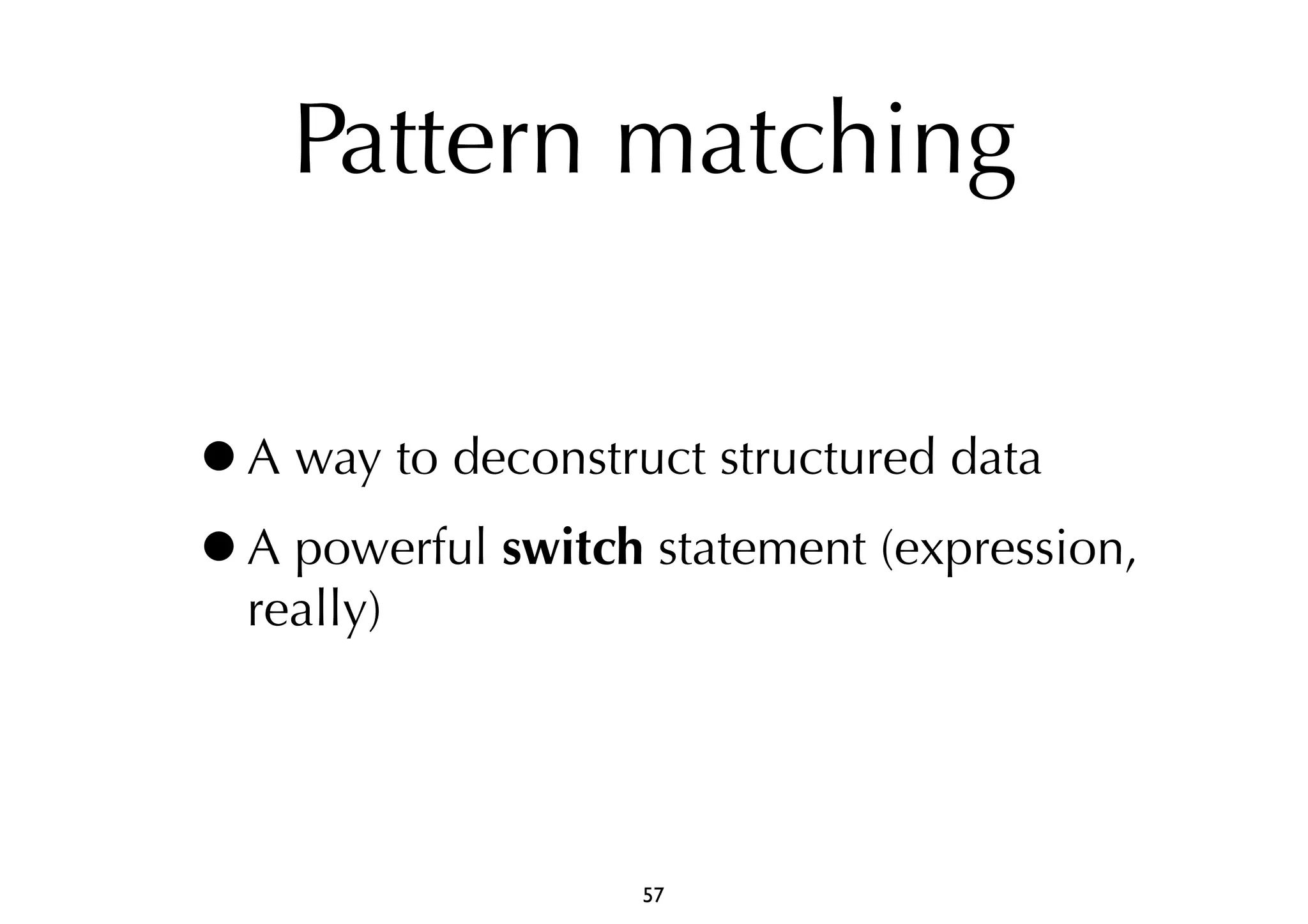
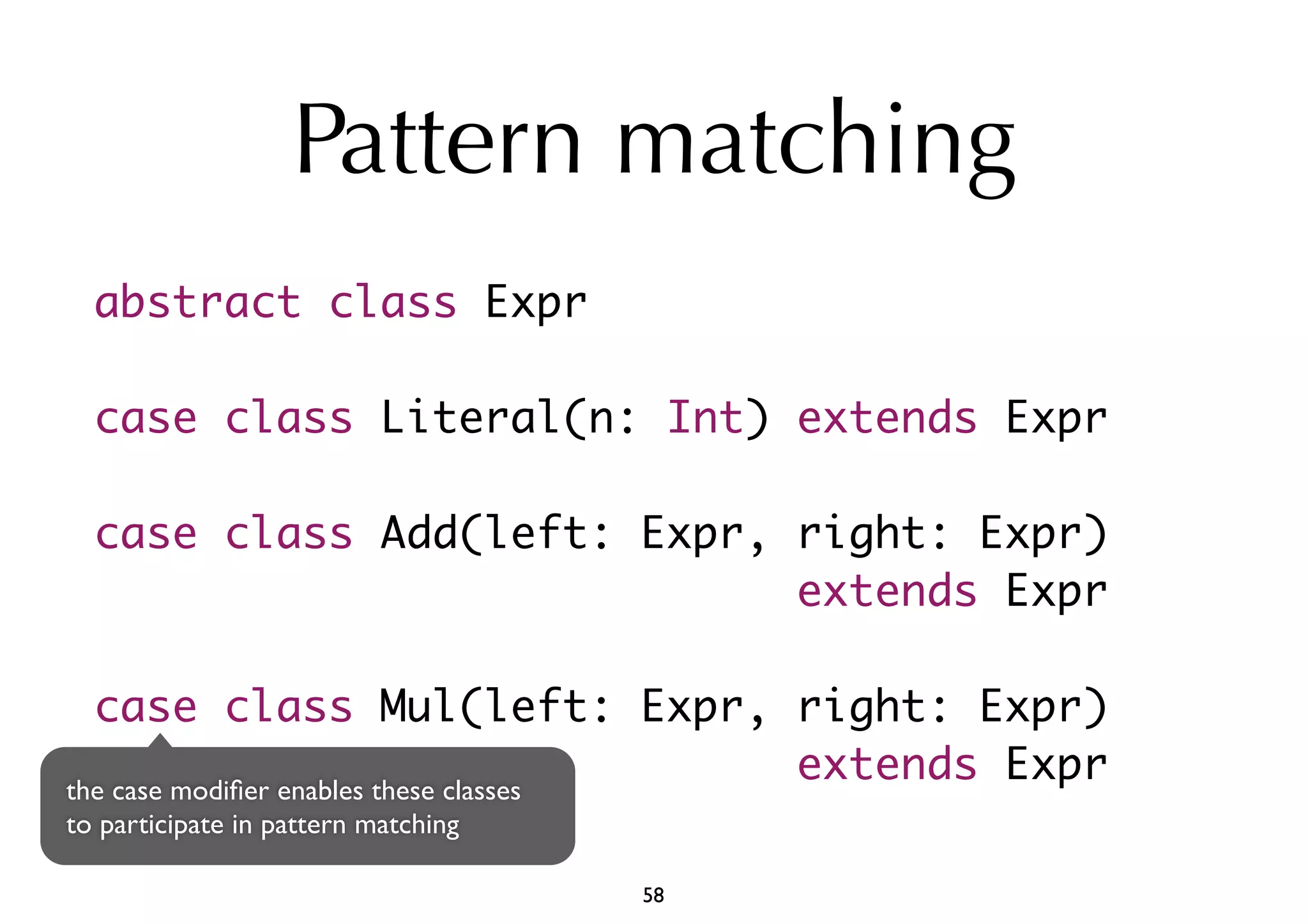
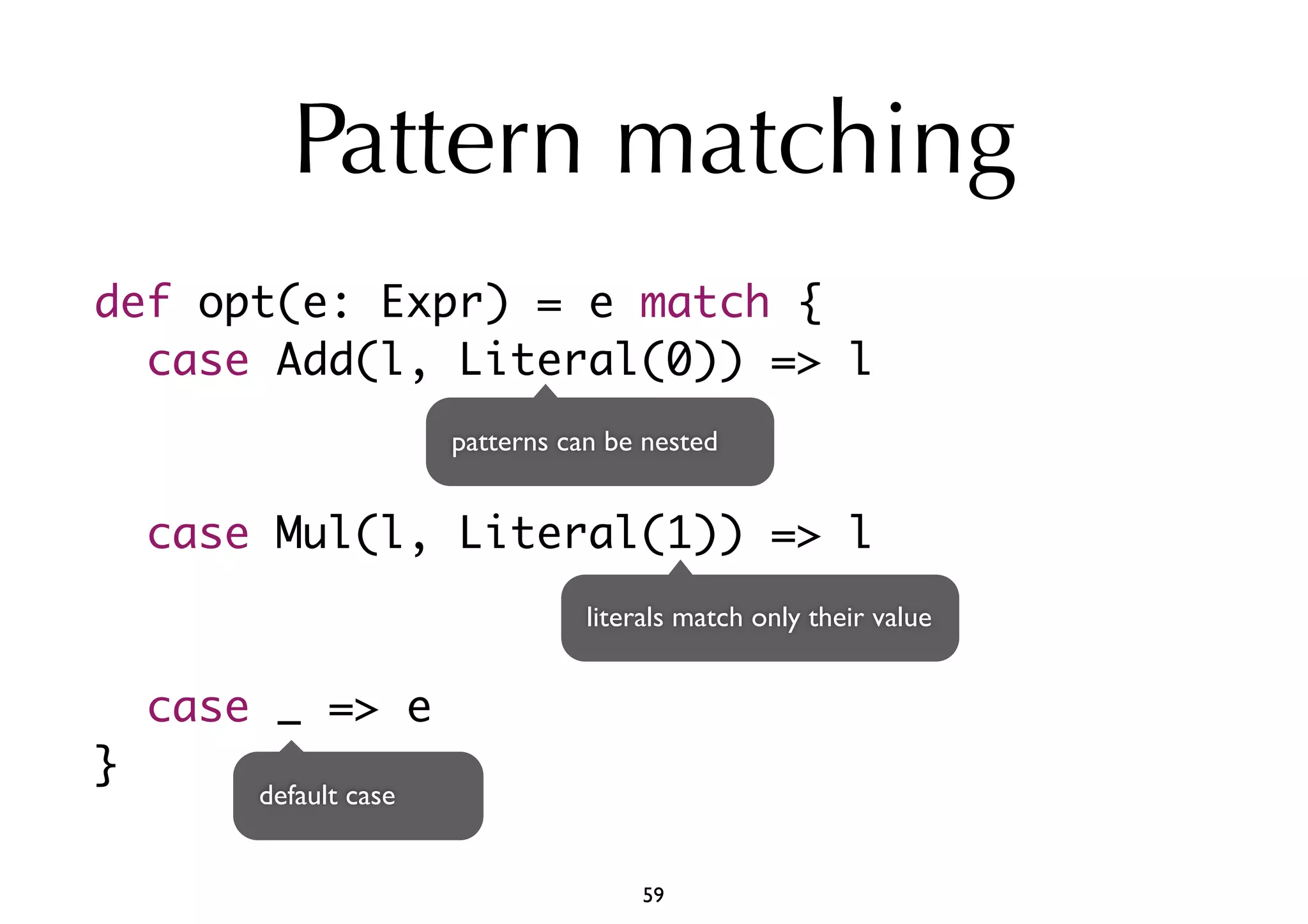
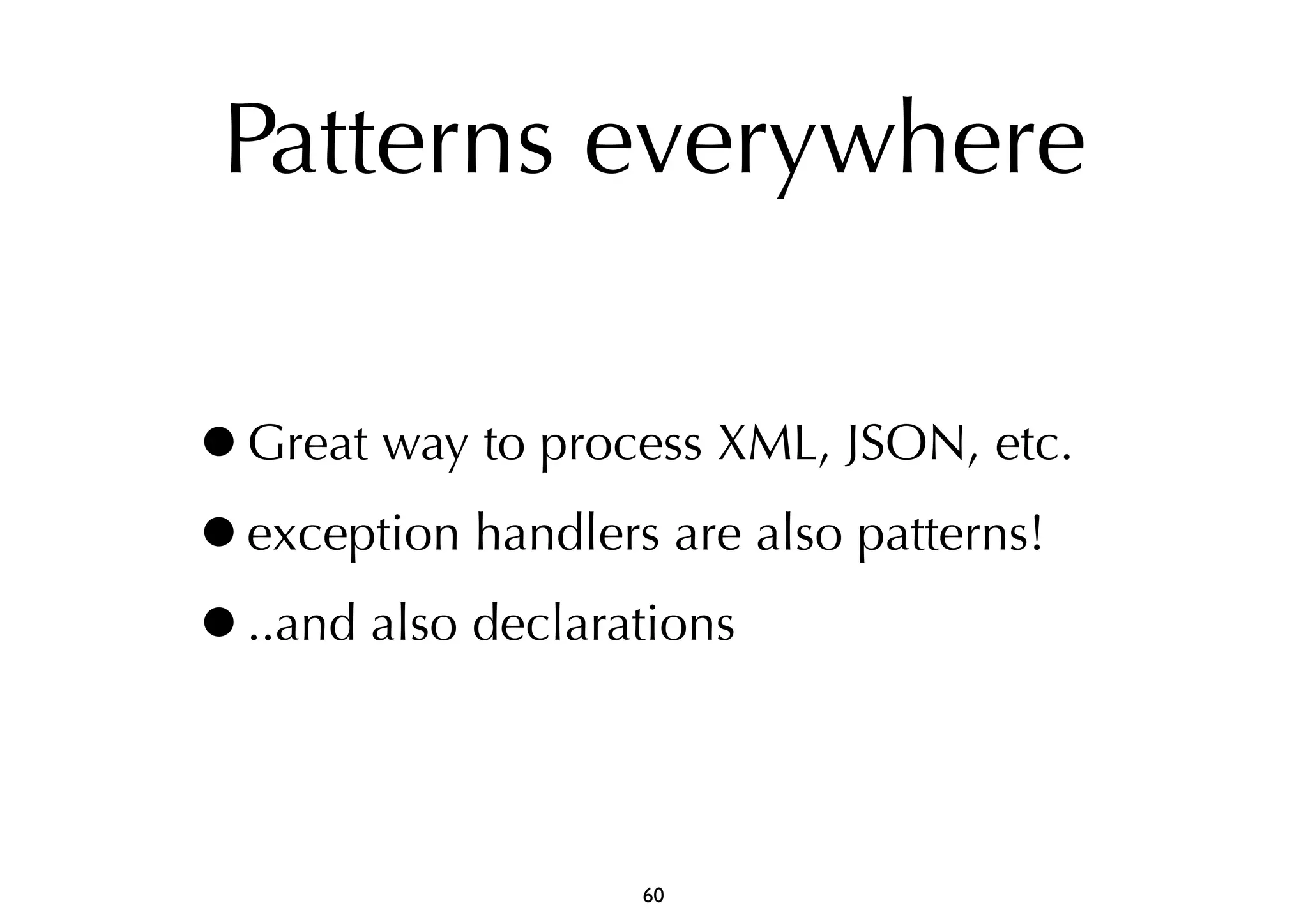
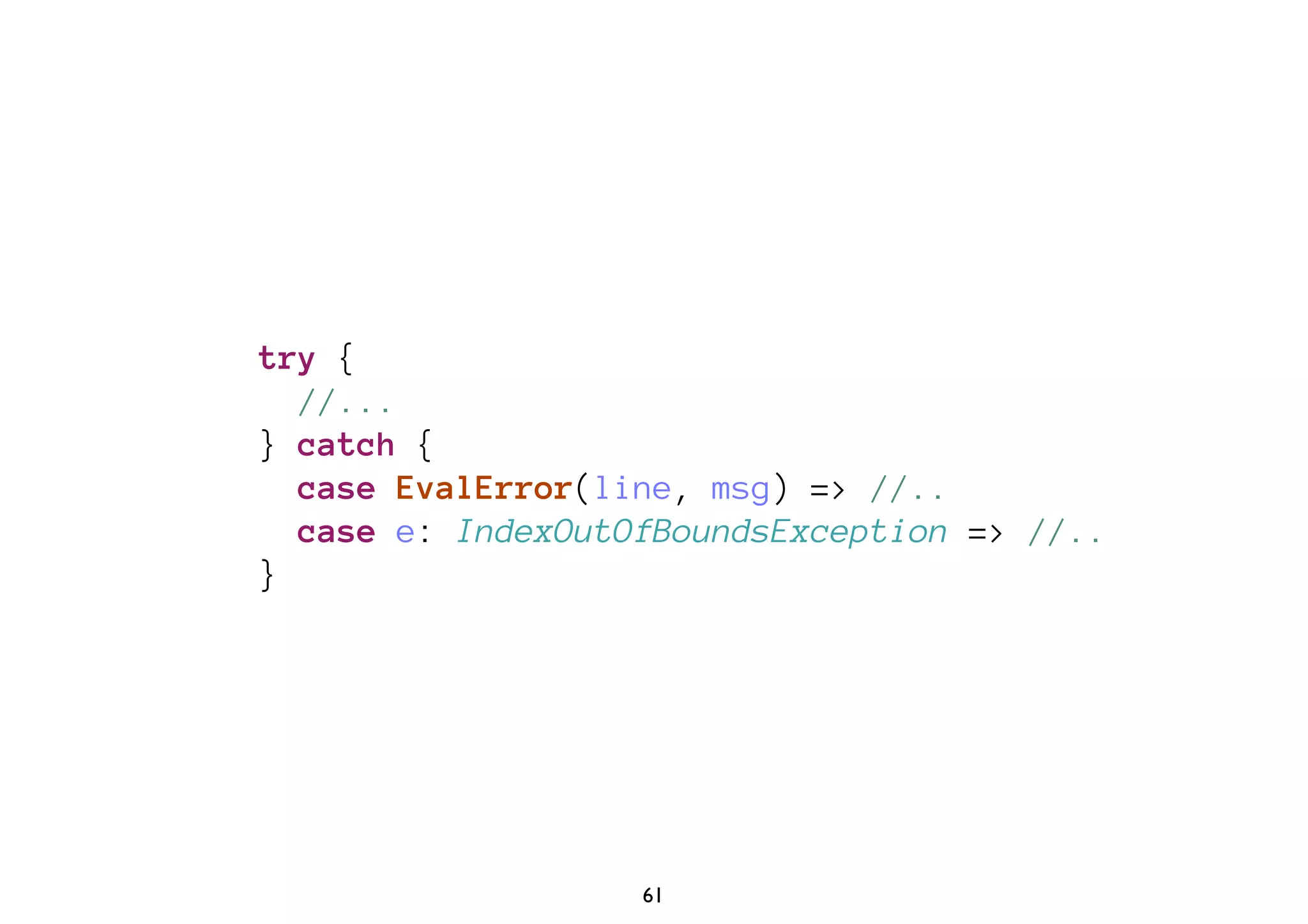
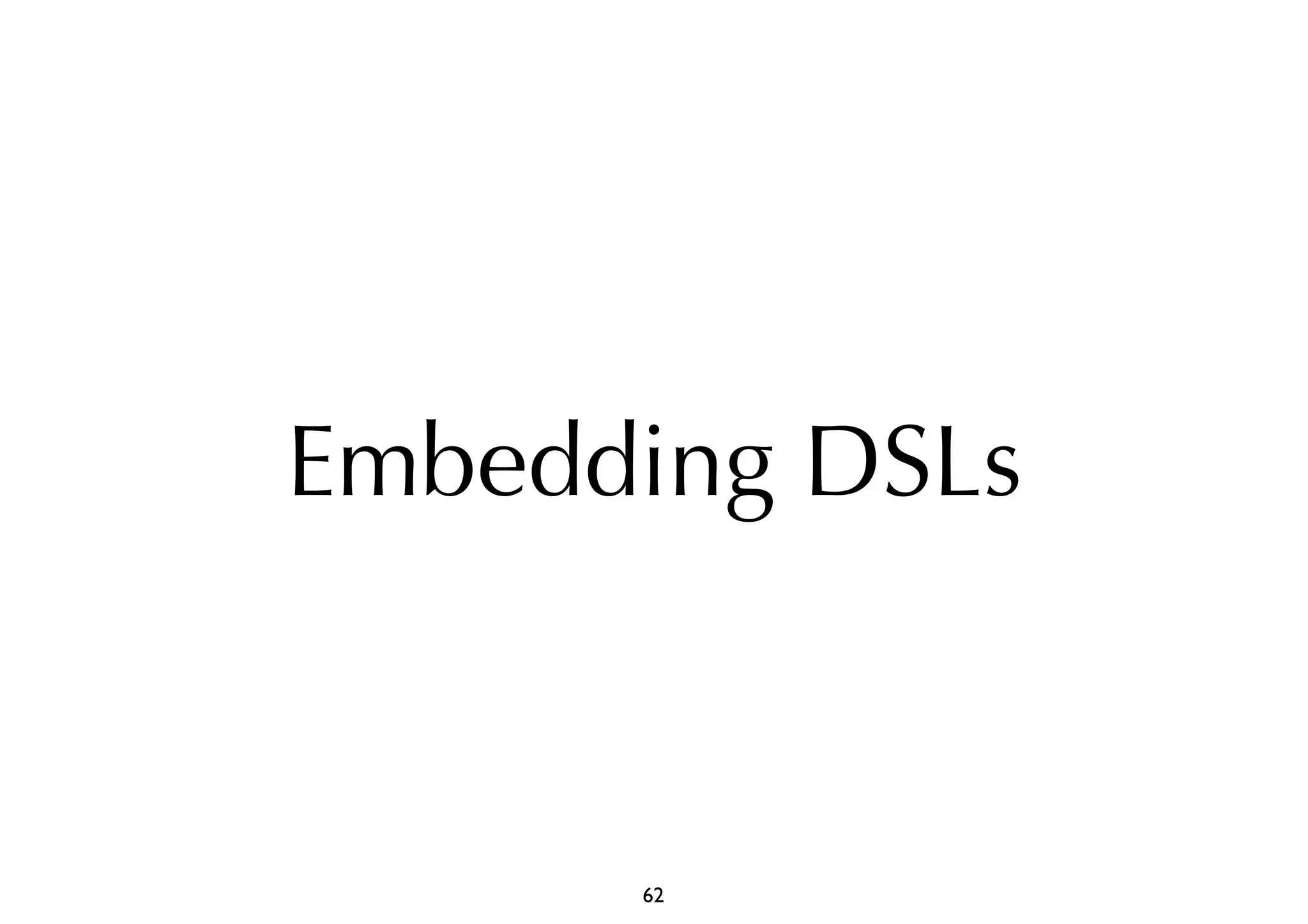
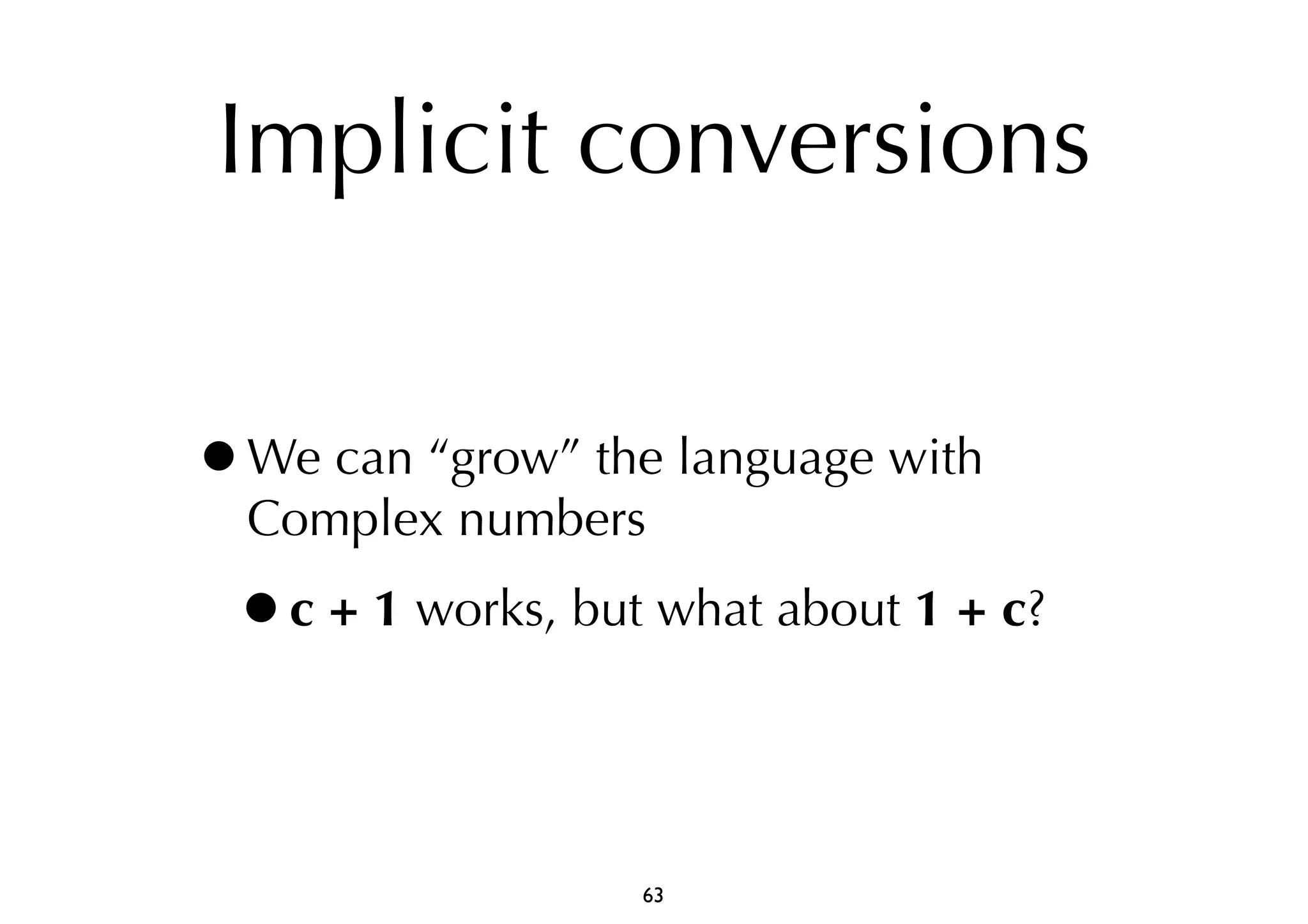
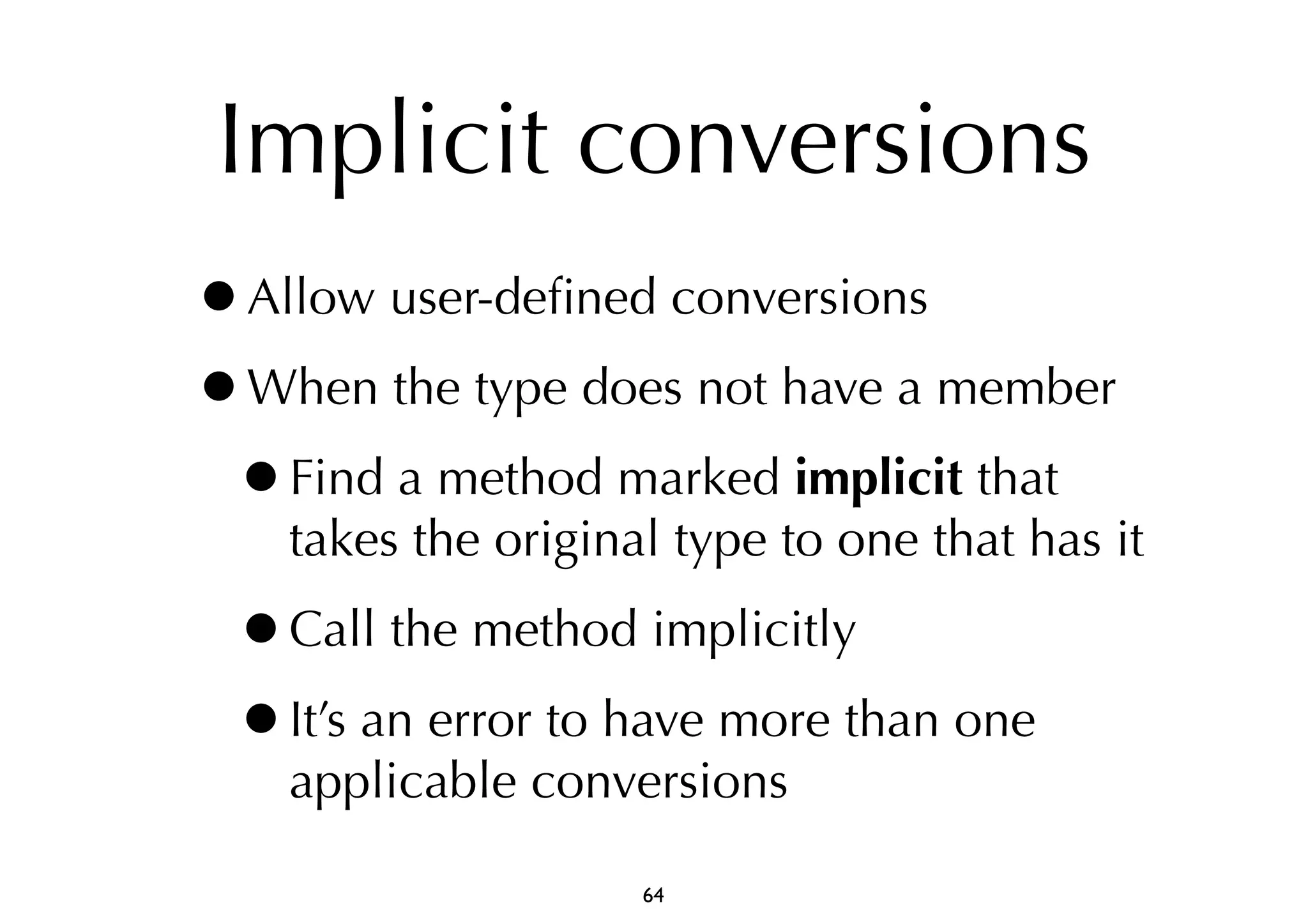
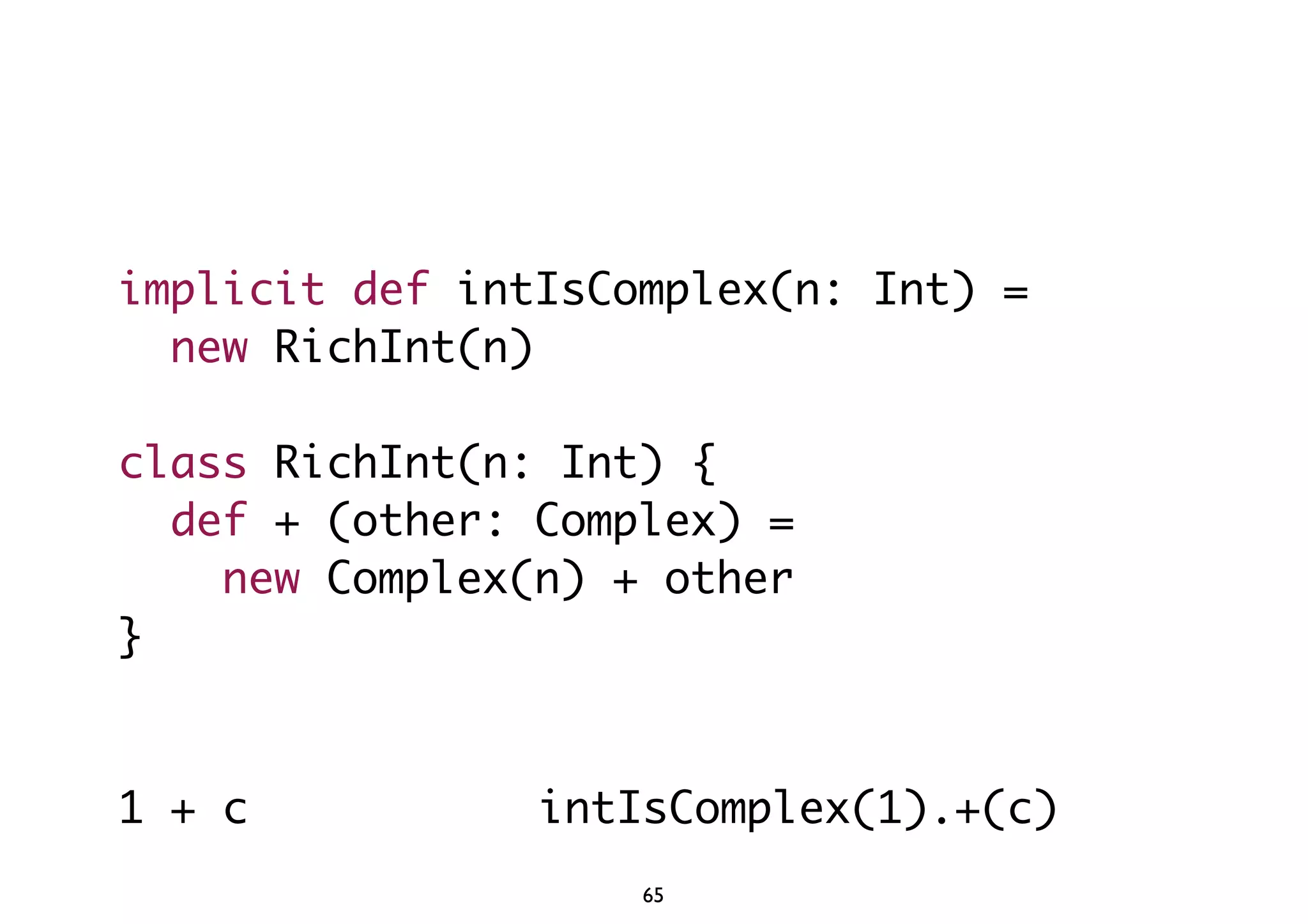
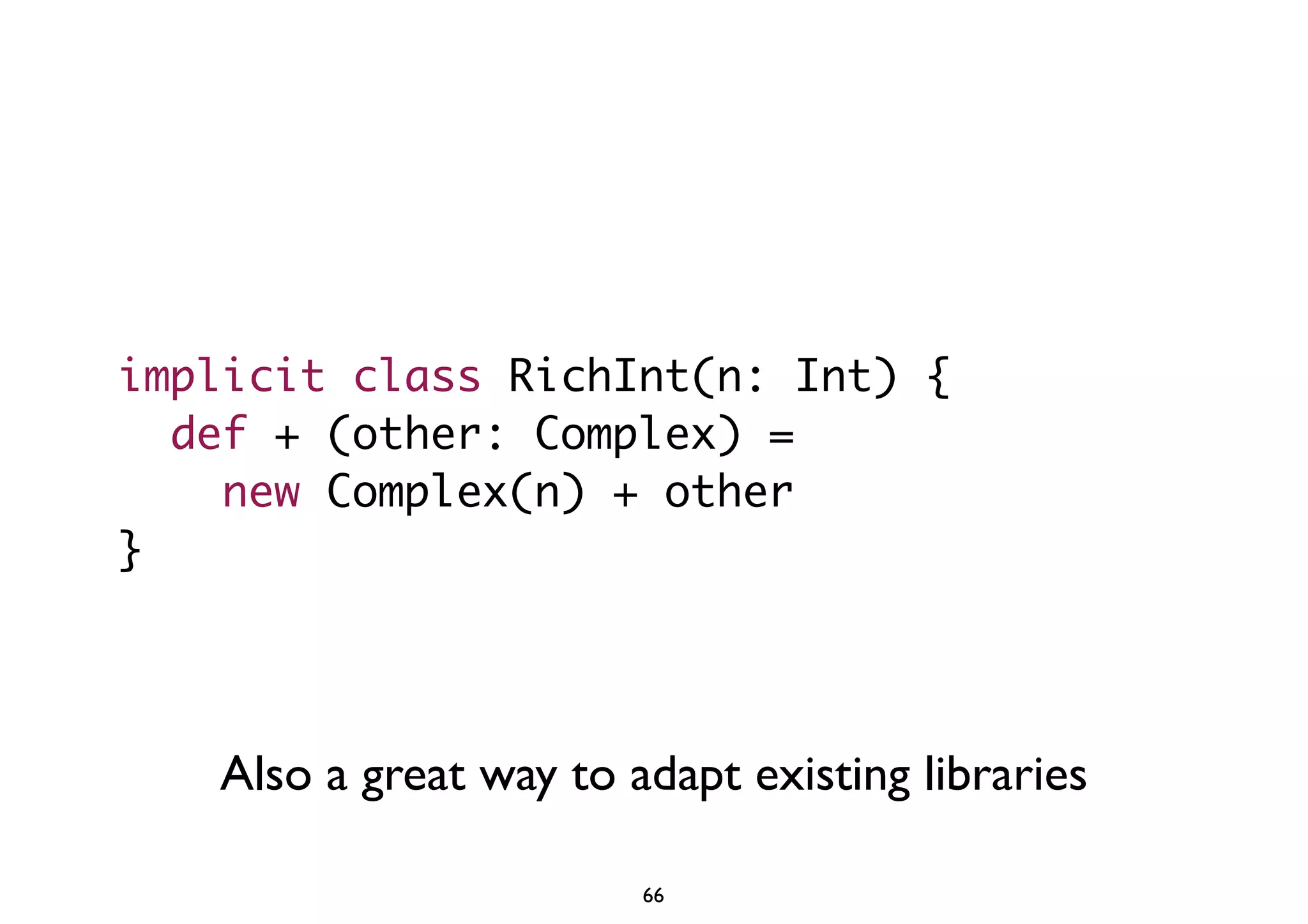
 {
def foreach(f: T => Unit) = ???
def map[U](f: T => U) = ???
def filter(f: T => Boolean) = ???
// ...
}
Scala arrays are Java arrays, but can still have the same API
67](https://image.slidesharecdn.com/scalaintroidragos-141117184923-conversion-gate01/75/Scala-Object-Oriented-Meets-Functional-by-Iulian-Dragos-66-2048.jpg)
